Church architecture on Lanzarote
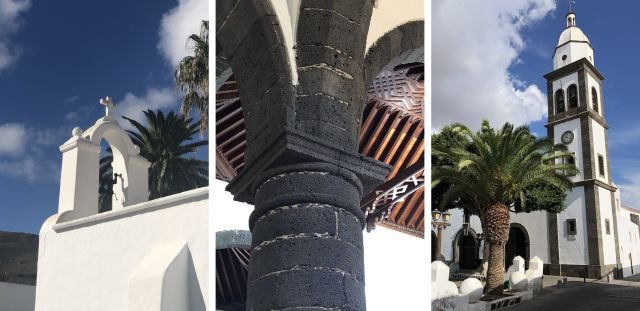

Since I am an architect who loves to deal with building history - which is known to be largely based on sacred buildings - it was of course obvious to write something about the church architecture of Lanzarote, the island of my adopted home. At first I thought there might be 15-20 temples here on our tranquil island, but no way, after a short research I could count not less than 56 churches on Lanzarote and I know that I haven't even included all of them! My thanks go to Mike Tovar (www.mike-tovar.de), who kindly made several of his photos available to me. I would also like to thank Noemi Rodriguez, Christian Schäfer, Liudmila Olshanskaya and Marit, the administrator of Trondheimsolistene (www.facebook.com/trondheimsolistene), all of them provided me also with photos. Furthermore I took four photos from the film "Die Quelle" (The source) by Rainer Erlar from 1978, in addition, this article uses photos from Wikipedia, all further photos that do not have an explicit source are of my own.
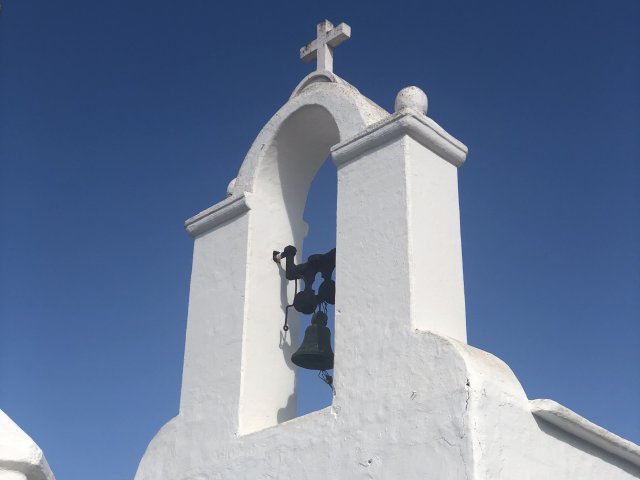
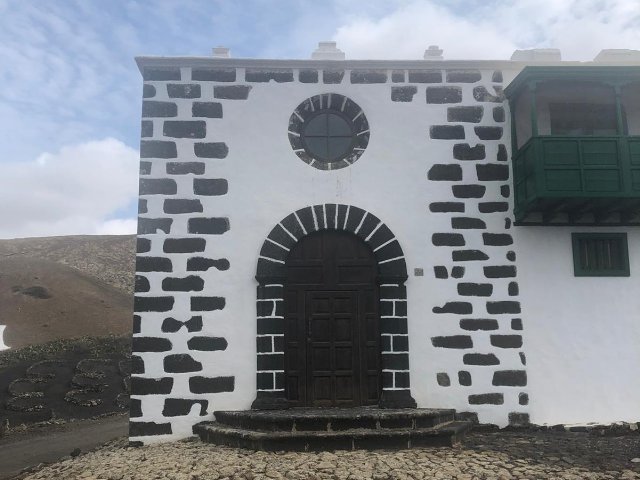
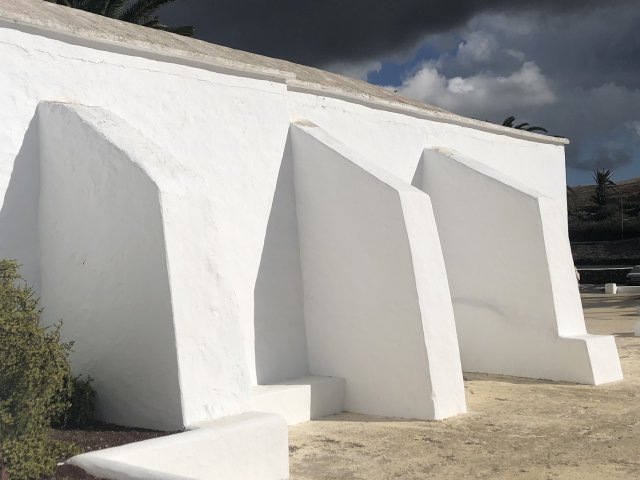
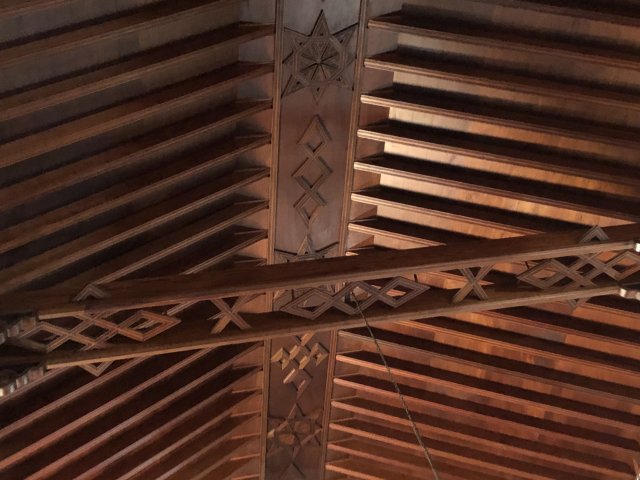
Lanzarote's church buildings are - with a few exceptions - more or less all built in a similar architectural style. Most of them are single-aisled, but some of them are also two-aisled buildings with plastered, white-painted outer walls. Many of them also have buttresses on their side walls and a sacristy attached to one of their side near the choir. Often there are also stone benches built between these buttresses. As a rule, the churches have a wooden arched portal, the border of which is normally bricked with basalt stones. Often one can also see exposed masonry made of basalt on the edges of the building or on the buttresses. Only a few of these churches have a bell tower, mostly one can just see an “espadaña”, a bell tower-like structure above the entrance facade, as is also known from many Mediterranean churches. The “Ermita” churches (hermitages) are usually surrounded by something as a “garden-wall”, at least the entrance area, that’s simply because of wind protection reasons. Inside, the buildings are often kept very simple and many of them have an open, wooden roof structure, which was either inspired by the Mudéjar architecture of the Moorish builders or even built by themselves. Very rarely one can see vaults or domes. In multi-aisled churches the arched arcades of the central nave walls normally rest on columns made of basalt, with simple capitals made of the same material.

Before starting, just a word about the buttresses: Perhaps someone asks why particularly the older, small churches have buttresses on the outer walls, even though they have such thick walls and, in comparison, to carry only a very light, wooden roof. But basically gable or hipped roofs are built on the Canary Islands - even today - according to the principle of the “rafter roof” (that's how we would call it in Central Europe). This means that a horizontal thrust is created via the rafters, which pushes the outer walls outwards at their top. But especially the older buildings with their thick walls are made of “piedras” (volcanic stones), which were normally walled up without mortar, at best clay was used as a kind of mortar. Of course, such a wall cannot absorb any horizontal force at its upper end, the volcanic stones would simply be pushed outwards, or with every small earthquake the top of the wall would move a little outwards until the roof finally collapses. The buttresses are there to prevent this from happening.
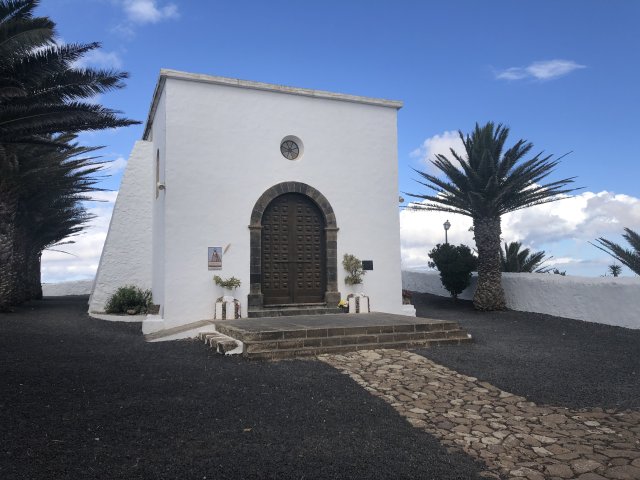
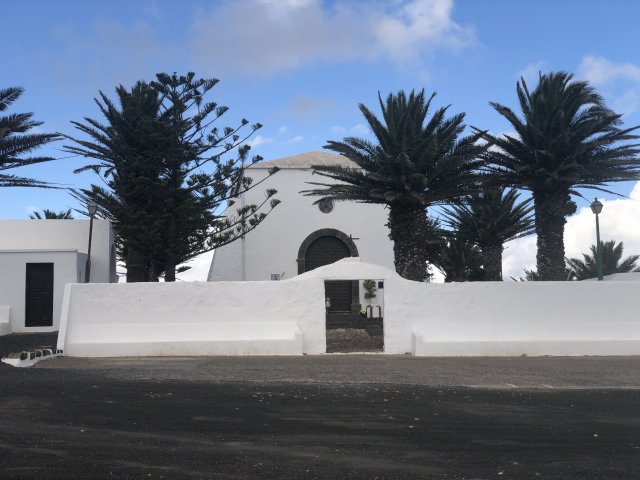
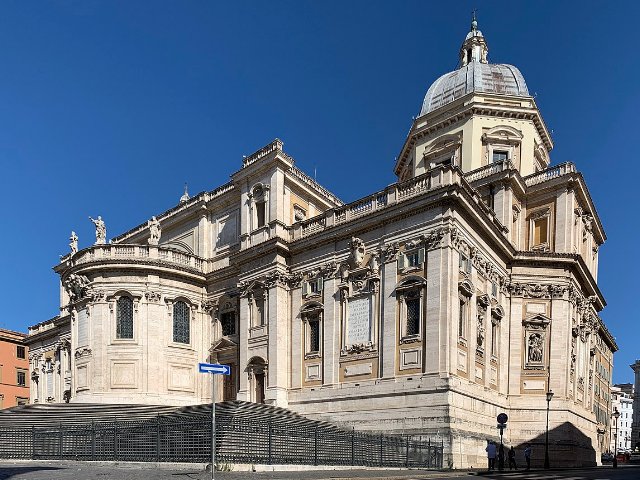
Already at the time of the conquest of Lanzarote by the Spaniards during the 15th century around 20 hermitages (Ermitas) were built on the island. Unfortunately, nearly nothing of these buildings has survived, even if some of them have been rebuilt. One of these temples is the Ermita de las Nieves church which was built from 1423 on the Risco de Famara mountains, above the famous Famara beach. It is probably one of the most emblematic churches on Lanzarote. In the book "Nuestra Señora de las Nieves" (Our Lady of the Snow) one can read how the building was destroyed and razed to the ground during a pirate attack in 1576. During the 17th century it was then reconstructed again, after the place had been abandoned for more than 100 years. Some renovation work is also documented for the year 1710. After the volcanic eruptions of the 18th and 19th centuries, during which the Virgen de los Dolores (“Virgin of Sorrows”) rose to greater importance, the Virgen de las Nieves reappeared a little forgotten and the church building was again exposed to neglect. In 1966 the remains were finally torn down and a new building was erected by the architect Henry Spínola from Teguise. The only thing that has been preserved is the old cistern (aljibe) on the site, which can still be seen today. The rectangular structure is covered by a hipped roof to which a tent roof is attached above the choir room. The church is not oriented to the east but more or less to the north, so the sacristy attached to the side of the choir adjoins on its east side. The buttresses along the side walls are very typical of Lanzarote churches. The entire complex is also surrounded by a wall, which is, on the other hand, typical of an Ermita. The Virgen de las Nieves was declared to be the patron saint of Lanzarote in 1725 (this was before the volcanic eruptions of Timanfaya), after having been venerated and worshiped for rainfall since the 15th century - according to legend, it once heralded a significant snowfall which should take place during an August, so a pilgrimage to this hermitage takes place until today every 5th August. To what extent such legends have a real core is of course questionable, but in this case one inevitably has to think of the genesis of the early Christian church of Santa Maria Maggiore in Rome, because here too it snowed on a 5th August, but as early as 352 AD...

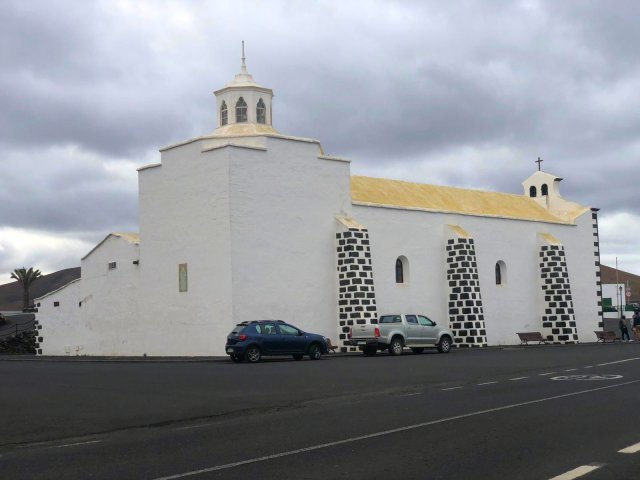
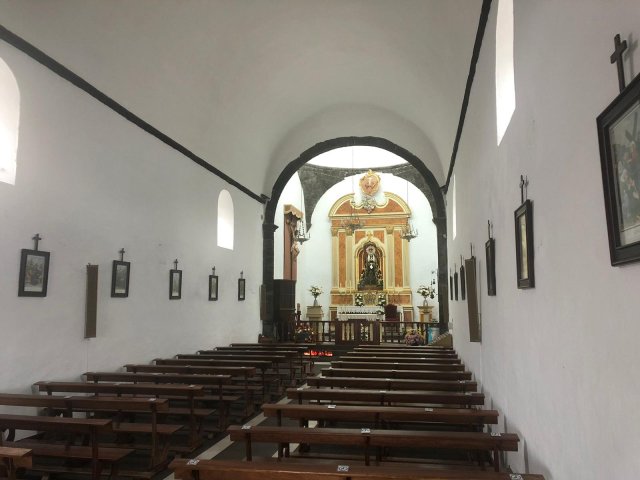
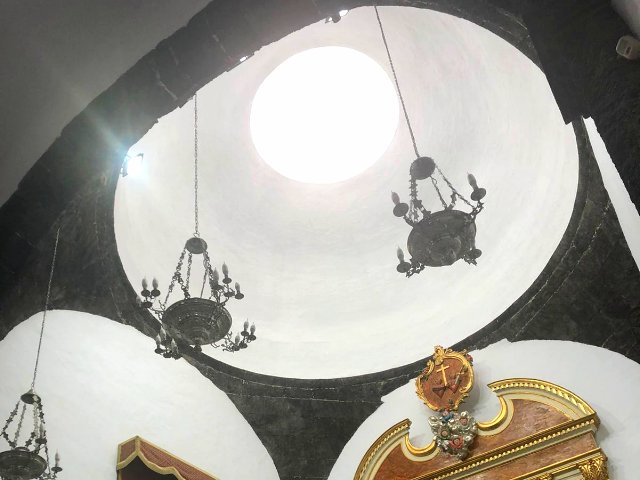

In Mancha Blanca we see the Ermita y Santuario (Sanctuary) de Nuestra Señora de los Dolores, I mentioned her already above as the Virgin of Sorrows. This church was built from 1780 after the volcanic eruptions of the 18th century (1730-1736), but was not completed before 1862, after the volcanic eruptions of the 19th century (1820-1824). The nave is covered with a flat gable roof over a barrel vault, while a pendentif dome with a lantern rises above the choir, an element which is of course often seen in baroque churches, but on Lanzarote it is an exception. It is actually the only such dome on Lanzarote. The pendentifs - the parts of the dome which lead from the square of the floor plan into the round of the actual dome - are clad with black lava stones, while the dome itself has been plastered white and is crowned by a lantern. The construction of this church is therefore very complex. Mighty buttresses along the nave walls absorb the horizontal thrust of the vault and divert it into the ground. A sacristy is also built on the south side of the choir. According to legend, the Madonna figure of the Virgen de los Dolores was brought near the lava flows during a procession, where she miraculously managed to stop them and thus saved the inhabitants and their homeland. Since then, the pilgrimage on the Virgen de Los Dolores day to Mancha Blanca has been held every year on September 15th, when the inhabitants make a pilgrimage from all parts of Lanzarote to Mancha Blanca. It is one of the largest celebrations on the island, where alcohol is also often awarded in addition to the actual pilgrimage. The island government has always to work hardly to bring the many pilgrims in the evening back by bus to their villages. The Virgen de Los Dolores is one of the two patrons of the island, along with the Virgen de las Nieves.
The ambivalence of these two figures, the Virgen de Los Dolores on the one hand and the Virgen de las Nieves on the other, seems interesting, as they are both dedicated to the most elementary fears of the islanders. One protects against the glowing lava, the other provides water. Especially the fear of volcanoes is clearly shown again with the recent eruption on the neighboring La Palma island. Before the outbreaks in Timanfaya, on the other hand, the Virgen de las Nieves who brought precipitations appeared to have been the more important, as she had only recently been appointed to be patron saint. How quickly the tide can turn! Even our modern times with our desalinated seawater and the current tragedy of La Palma will possibly generate a new polarization again.
According to a document from Bishop Manuel Verdugo of 1799, the parish of Tías was founded in 1796, along with those of Tinajo, San Bartolomé and Arrecife. At that time only the parish in Teguise and the two auxiliary parishes in Haría and Yaiza existed.
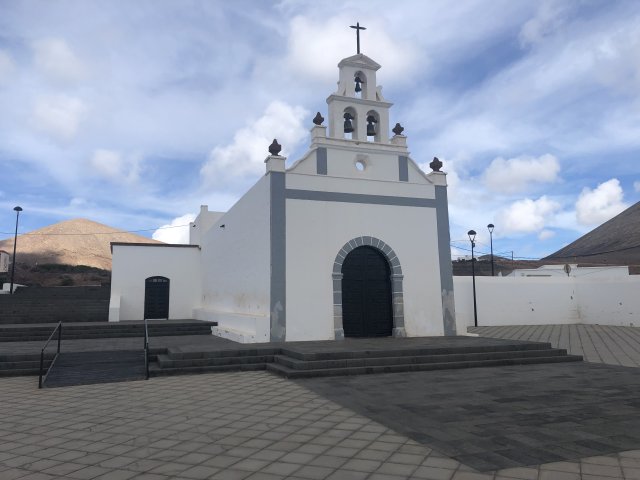
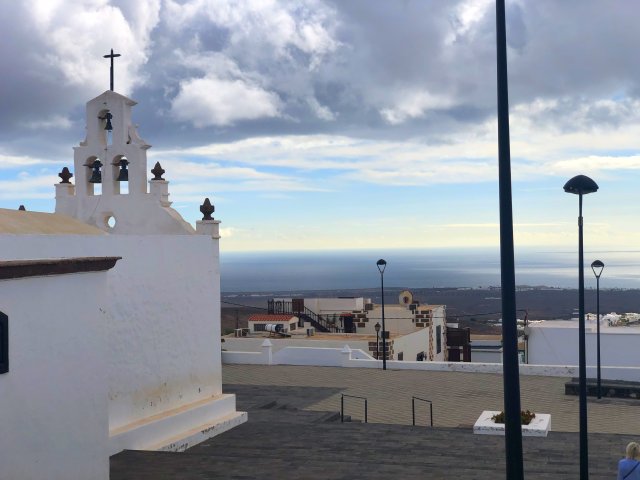


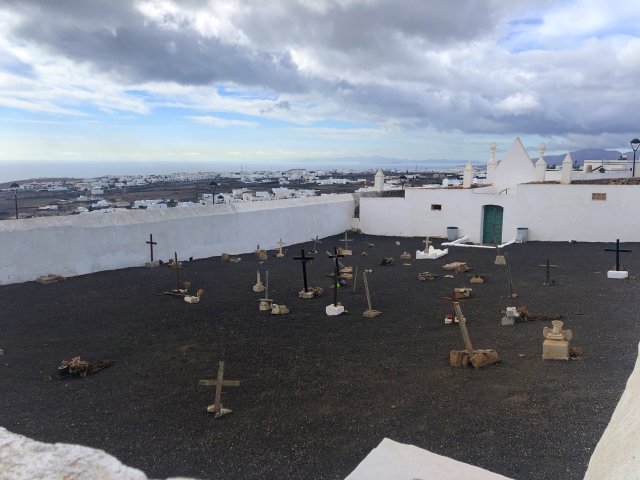

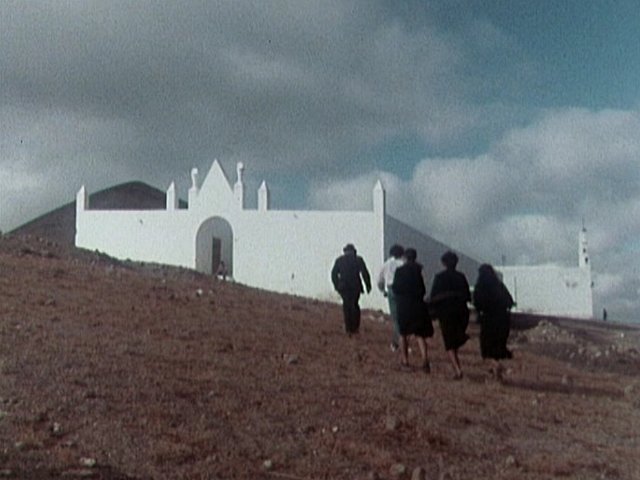
The current church of Nuestra Señora de la Candelaria was built in the newly built settlement of Tías during the 18th century, after the volcanic eruptions of Timanfaya (1730-1736). It already had a previous building, which was destroyed in 1735 by the lava during the eruptions. It is believed to have been between the mountains Tisalaya, Chibusque, Juan Bello and Montaña Colorada. It was first mentioned in a document of 1661. This previous building was also already connected to the Virgen de la Candelaria, which supposedly appeared to the Guanches in the middle of the 15th century. It is said that families from Fuerteventura brought the original picture of the Virgin to Tías after it was captured by the Castilians on Tenerife, even if it was later brought back there. A cemetery was also laid out there in 1799, right next to the church, it is the oldest one of Lanzarote. The Virgen de la Candelaria (Virgin of Light) is venerated as "Black Virgin", she is the patron saint and at the same time one of the oldest dedications of the Canary Islands, but is also venerated in the entire Latin American area - she advanced to be one of the most important figures of Mary on the American continent, alongside the Virgin of Guadalupe, who is the patron saint of Mexico. She is also historically closely linked to the volcanic eruptions of Lanzarote, as is today's patron saint of the island, Nuestra Señora de los Dolores. The single-nave church has a very high, two-story espadaña on its entrance facade. This church also looks a little baroque due to the design of its gable, even if the edging of the facade with gray, pilaster-like stripes is unusual. The building is oriented to the north and has a sacristy attached on its west side. The building is situated on a very elaborately built terrace, from where one has a fantastic view over Tías to the Atlantic Ocean.
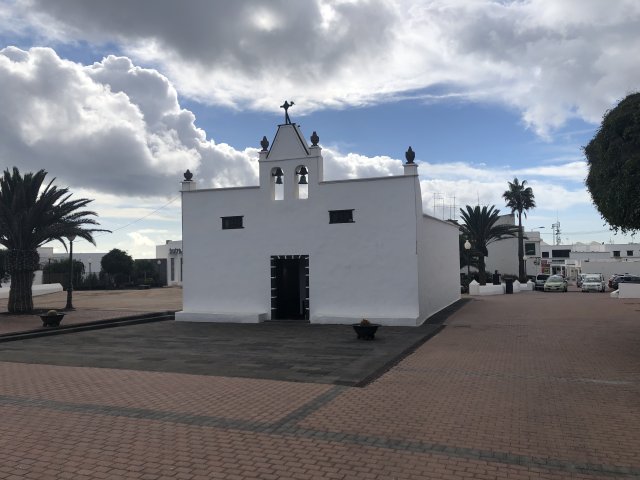
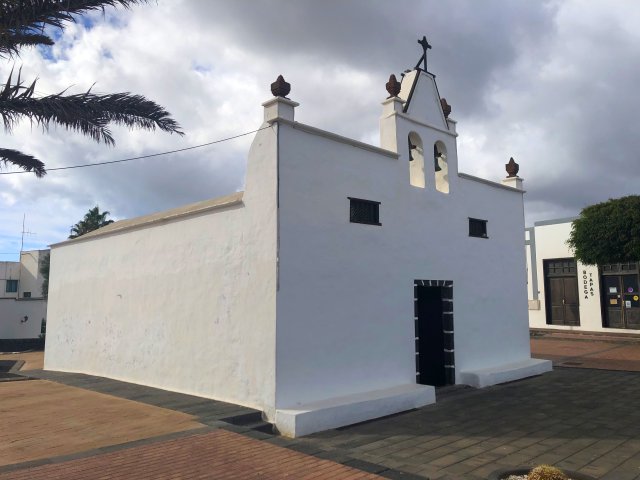
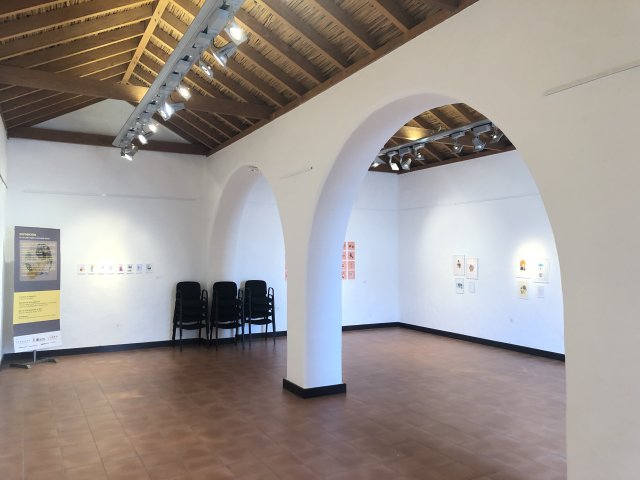
The Ermita San Antonio (Santuario San Antonio) is also located in Tías, even if this building has not been a church since the 1970s, but is used since then by the community of Tías for cultural purposes. It was formerly a zilla of the church since the 17th century, where the citizens had to pay their tithes, but also used as a storage hall for agricultural products and furthermore it served as a barracks for the troops who took part in the Cuban War of Independence. In 1907 the building was converted into a church at the behest of Pastor Sinforiano Suárez. This happened because Nuestra Señora de la Candelaria was too far from the town center. It is a small, two-aisled building with a rectangular floor plan and a similar looking facade, above which there is an espadaña in the center. In contrast to many church buildings, the wooden entrance portal of the Ermita in Tías does not have a round arch but a straight lintel. The building has been lovingly restored and has a roof structure on which there is a cane braid over the rafters.
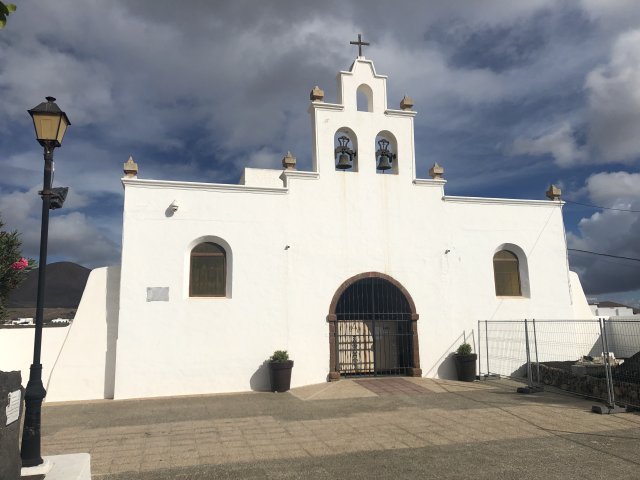
The aforementioned Ermita San Antonio in Tías should not be confused with today's parish church of San Antonio, which is situated across the street! The parish church was built from 1972 because the Ermita became too small, so it replaced it in its function as a parish church. The facades of these two buildings look very similar, except that the parish churchs facade is significantly larger and has furthermore a round arched portal. There is also an arched window on the right and left of it.

The Ermita de Santa María Magdalena is located in the mountains, between Conil and Masdache, a place called “Entremontañas” which means “between the mountains”. The simple building faces east and is attached to an old farmhouse. From the small hill on which it is located one gets a beautiful view of the wine-growing area. It was built in 1772, this was before the parish of La Candelaria in Tías was founded. It was erected by the Camacho family, so that their workers did not always have to walk to San Bartolomé to take part in the church service there. It is a very beautiful, right-angled building with a large, wooden arched portal which is framed with exposed basalt stone masonry. There is also a framed oculum above it. The red basalt stones have also been exposed over large parts of the facade. The building also has a buttress on its north side. Due to the lack of a cross, the building is not easy to identify as a church, but on closer inspection one can see that it was built in the same style as the other church buildings on the island.

There is another church in Masdache which is also called the Ermita de Santa María Magdalena. It is a very peculiar building - it has a rectangular floor plan, but the gable roof seems to be positioned the wrong way around - normally the eaves side of a roof is longer than the gable side, but not in the case of the church of Masdache! During my studies we called something like this to be a “cuckoo clock house”. Unfortunately, I don't know anything about how the decision came about to build the roof this way.
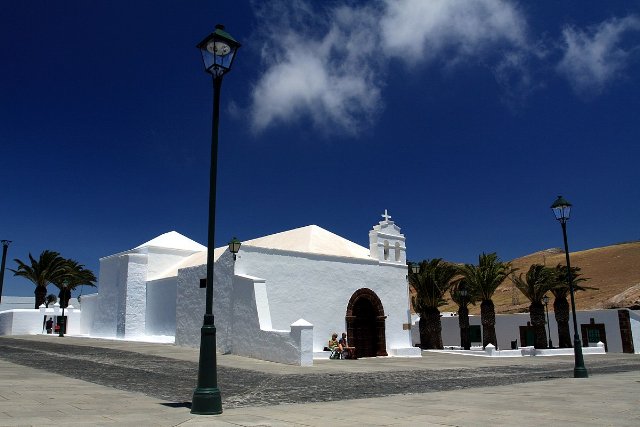
High up in the mountains, more precisely in Femés, above today's Playa Blanca, there is the Ermita de San Marcial de Limoges, also known as San Marcial del Rubicón. Its predecessor church originally was located at the coast and it was the Cathedral of San Marcial de Limoges, being the first cathedral on the Canary Islands! But in 1483, shortly after the diocese was founded, it was moved to Las Palmas due to the large number of pirate attacks. In the 16th century, the former cathedral was finally destroyed during a pirate attack. Today's Ermita de San Marcial de Limoges was built in Femés in the 18th century. The single-aisled building is covered by a flat hipped roof, while a slightly higher tent roof rises above the choir room - a roof landscape as found on many churches on Lanzarote. A sacristy is also built to the east of it.
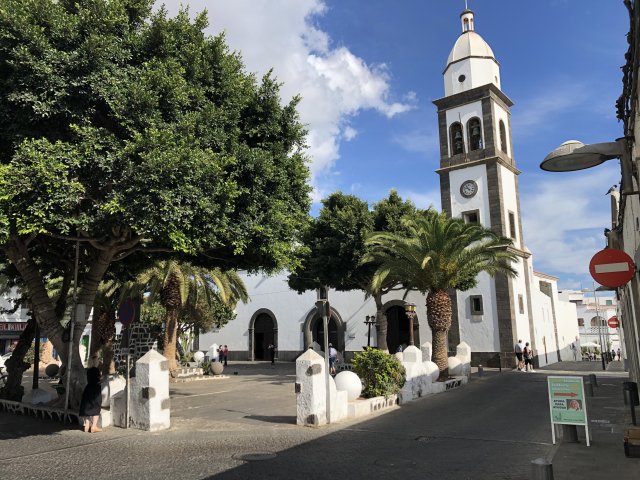
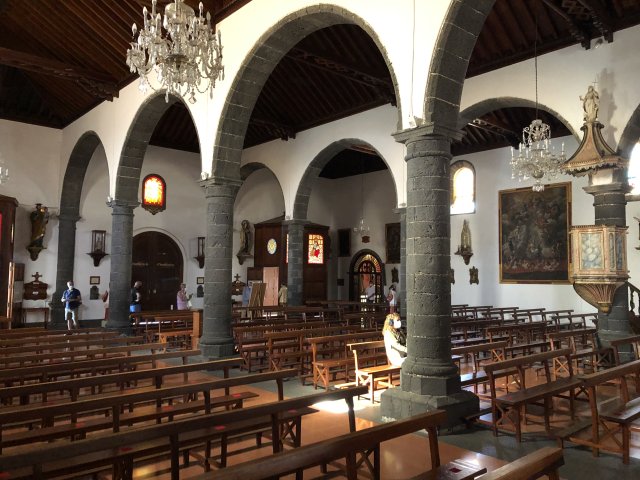
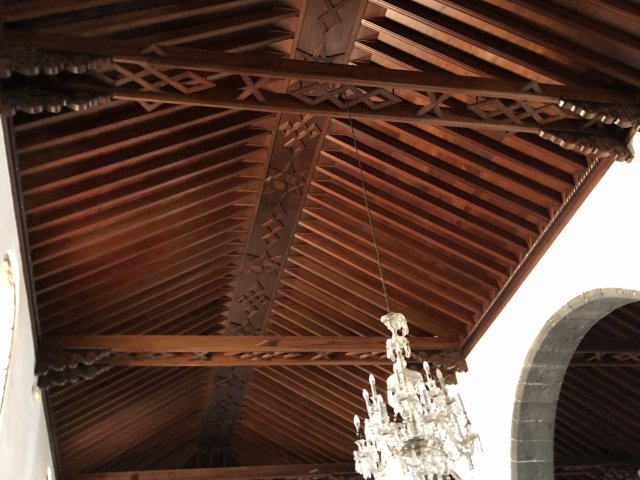

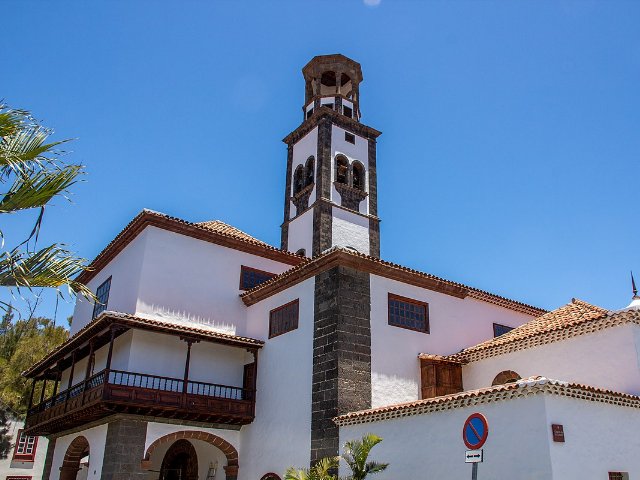
In Arrecife, on the Plaza de Las Palmas Square, between the pedestrian street Calle León y Castillo and the Charco de San Gines lagoon, one can find the current parish church of Arrecife, called San Ginés Obispo, which goes back to the city's first hermitage in 1574. In this church, beside of an image of St. Peter there is also worshiped a painting of St. Ginés of Clermont (San Ginés). According to legend, the latter appeared floating above the Charco de San Ginés - he is now the patron saint of Arrecife, in whose honor the Fiesta de San Ginés takes place every August, having its main day the 25th, when his image is worn in a procession through the streets of Arrecife. San Ginés is built in its current form as a three-aisled hall church with three open roof trusses of the same height, even if the side aisles have been added in the 18th and 19th centuries. The roof trusses are referred to as a Mudéjar construction, although some Spanish art historians doubt whether the Mudejares erected wooden roof trusses, because they were primarily excellent masons, both with brick and natural stone, and because of their origins building with wood was rather unusual for them. Interestingly, there is no Mudéjar dome in the Canary Islands, but there are many wooden structures that are attributed to them. So it is possible that these roofs were just inspired by the Islamic architecture, when the Mudejares came to the Canary Islands after their expulsion from Spain Mainland. In any case, the church has a transept, which is separated from the naves by three triumphal arch-like partition walls as well as by two steps on the floor. The steeple was added in 1842 and is probably inspired by that of the parish church of Nuestra Señora de la Concepción in Santa Cruz de Tenerife. It has a white dome at its top.
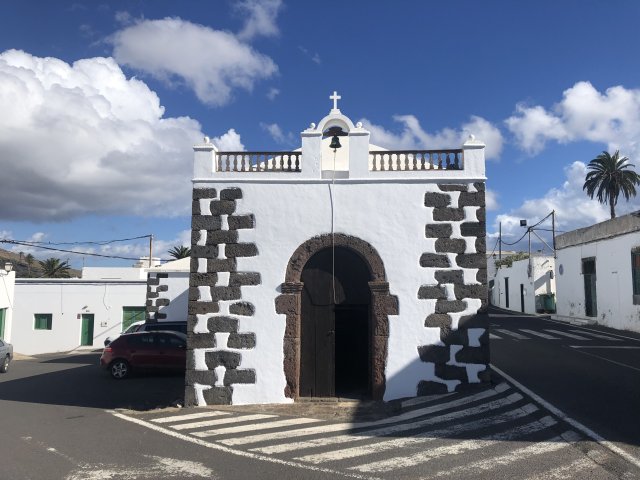


In Haría, in the north of the island, we find two churches, one of which is the Ermita de San Juan Bautista from the early 17th century, which also has a “Mudéjar ceiling” in its interior - the muslim people who, after the reconquest of the Iberian Peninsula, remained in Spain were called “Mudejares”. They performed their services on behalf of the new, Christian rulers. Among other things they built many churches in Spain Mainland. Teruel in today's Aragon can be described as the “capital of the Mudéjar style”, but some buildings on the Canary Islands also have elements of this style, such as our little Ermita de San Juan Bautista in Haría. A special feature here is that the building was erected without any buttresses, instead there are several wooden tie beams in the ceiling level of the roof structure, which make the buttresses appearing obsolete (see photos).
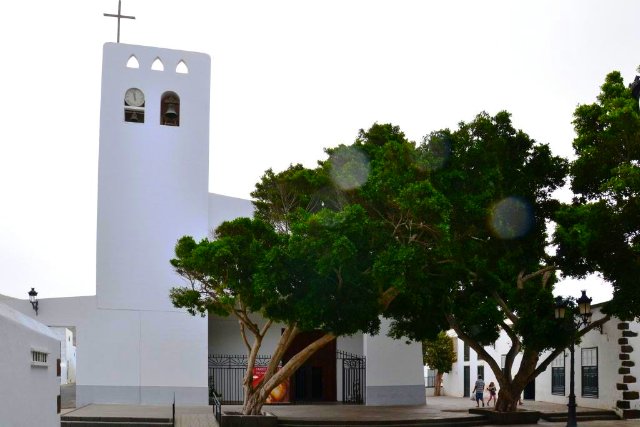
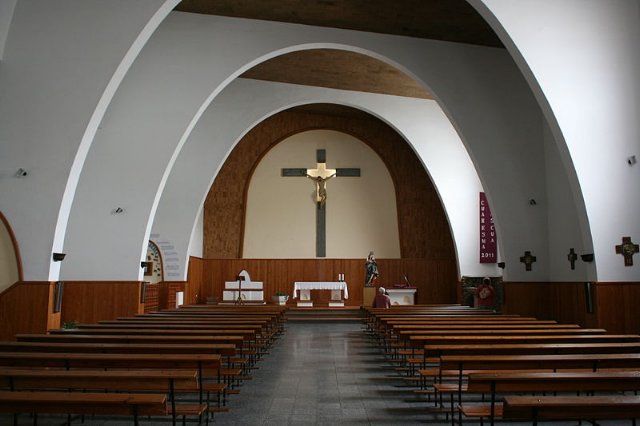
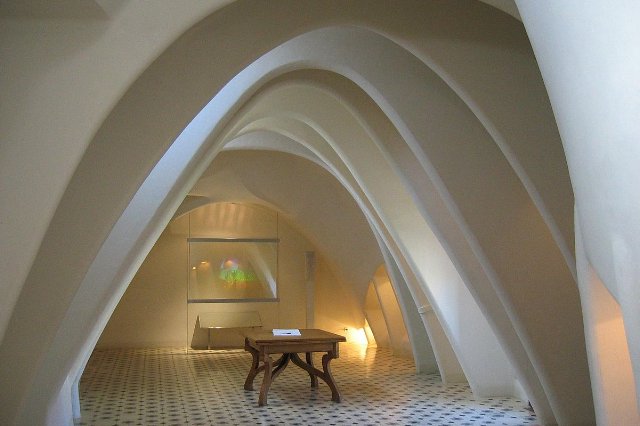
The second church in Haría is Nuestra Señora de la Encarnación, situated at the east end of Plaza León y Castillo Square - visitors of the Saturday market in Haría are certainly familiar with this building. It was originally built in the 16th century, but then destroyed during a pirate attack in 1618 - a fate that unfortunately many buildings of Lanzarote had to suffer in the course of their history. It was rebuilt in 1672, but then destroyed again in 1956 and rebuilt in its current form after severe storm damages - with somewhat strange-looking arches in its interior, which were designed according to the principle of the chain line (cosine hyperbolicus) giving the building a strange, modern-constructivist ambience, although this motif is very reminiscent of the top floor of Antoni Gaudí's Casa Batlló building in Barcelona, which also has such arches.

Furthermore, each village belonging to Haría has its own church. So we remember Nuestra Señora del Carmen in Arrieta, built in the 20th century - while the Virgen del Carmen is the patron saint of fishermen. A statue of the Madonna is inside this small church, which is taken every year out to sea by the fishermen - if the weather permits - as part of a maritime procession. The single-nave building is covered by a hipped roof, in the entrance facade there is a wooden arched portal and an espadaña on the roof, which houses the bells.
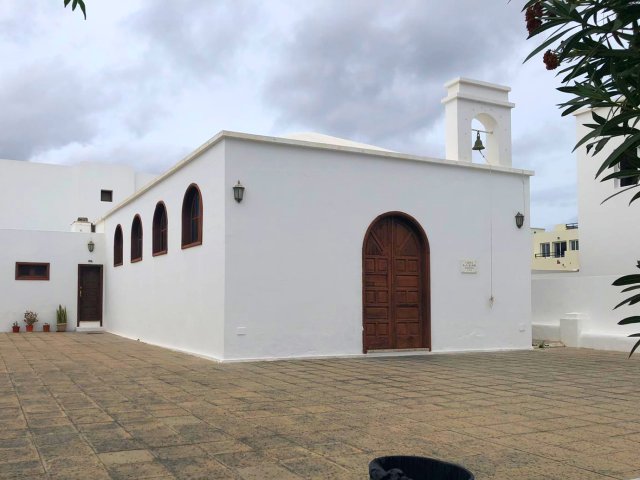
Punta Mujeres - the origin of this name has been heavily speculated about for decades - until the first half of the last century mainly meant salt economy. In addition, the place was uninhabited, because as part of the "Malpaís de la Corona" (the bad land of the Corona vulcano) it was an inhospitable area, which, in addition to salt production, was only suitable for fishing or collecting firewood. After the salt pans experienced a great boom until the 1950s, the yields of local production fell sharply from 1960 onwards. Previously, salt was mainly used to preserve fish, but then ice was used for this purpose. With the decline in the saltworks business, tourism began very slowly as early as the 1970s and houses were built accordingly. The notes of Gregorio Barreto Viñoly from Haría tell us that Don Antonio Cabrera Lemes donated a piece of land in the late 1960s, together with a German partner, in order to build today's village church of Nuestra Señora del Pino. This church is also a single-nave building, facing northwest and with a sacristy attached to its southwest side. The simple building has a hipped roof and a wooden arched portal on its entrance facade, as well as an espadaña on the roof.
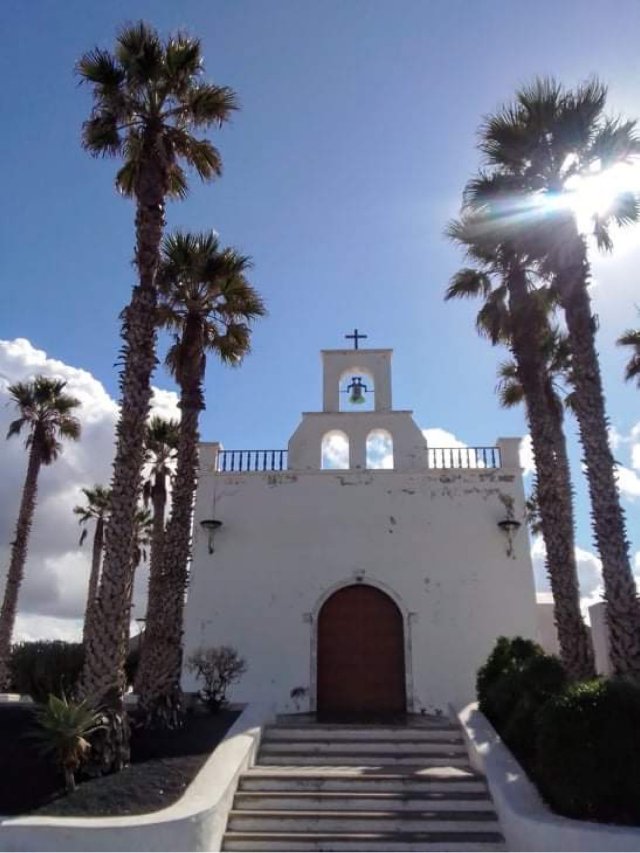
In Ye there is the San Francisco Javier Church, built in 1936, which is well known for its exceptionally good acoustics. In earlier times it was often used by vocal artists, but whether it is still possible to rent there to sing is beyond my knowledge. The modern building is based on a rectangular floor plan with a flat roof, just above the south-facing choir a tent roof rises. The outer walls are smooth and have no buttresses - cement as a new building material of the 20th century made this possible. To the left and right of the choir room there are side chambers which give from the outside the impression of a transept, even if this does not reflect the interior of the church.

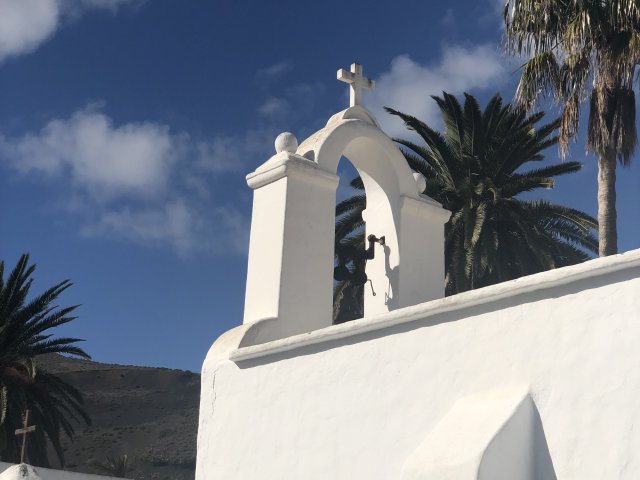

The Ermita de Santa Bárbara is located in the small community of Máguez, immediately north of Haría. Inside this church there is an altarpiece by César Manrique, who was available as a creative mentor during the construction of the building - it is the only religious work by Manrique. The simple, rectangular building with its hipped roof was built in 1972-1974 replacing a previous church from the 18th century that was in ruins. The large forecourt with its shady trees is particularly beautiful. As a quote from the traditional Ermita architecture, the small patio in front of the entrance surrounded by a wall is used, as can be seen, for example, at the Ermita de San Rafael in Teguise. Possibly this was even a model for the church in Máguez.
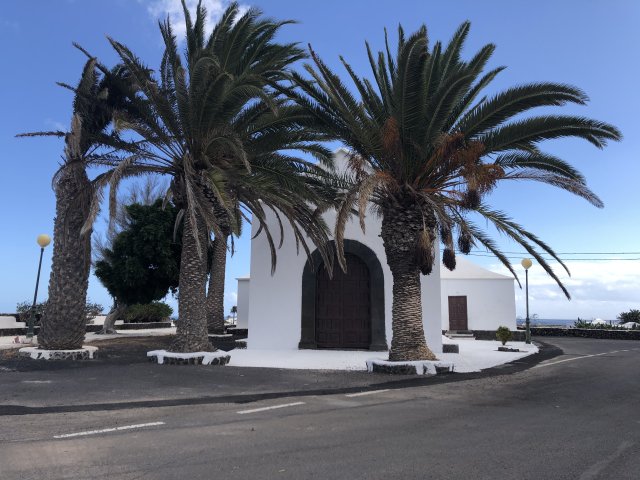
Mala also belongs to the municipality of Haría and there is also a small church built in 1809, namely Nuestra Señora de las Mercedes - the patron saint of the village. “Merced” is the Spanish word for mercy, but one also speaks of “dejar (algo) a la merced del viento” - to let (something) to the grace (or fate) of the wind. However, the worship of the Señora de la Merced originally began in Famara (see below). The simple, rectangular building, like many other Lanzarote churches, has a flat hipped roof. The entrance facade has a large, wooden arched portal with an oculum above it, as well as an espadaña on the side facing the town. As is typical for the island, a sacristy has been added to the south of the choir. During renovation work in the late 20th century, a mirror-inverted room was also added on the north side, so that, similar to Ye, the impression of a transept is created, which, however, does not exist at all.
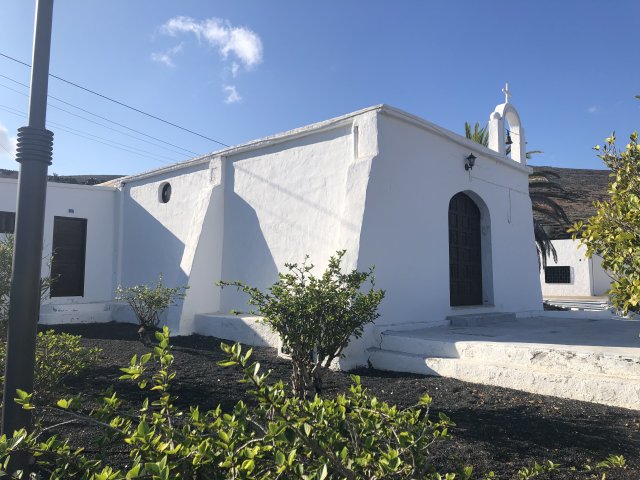
Tabayesco is a small village right at the entrance of the beautiful Valle de Temisa valley, which extends from Arrieta almost to Haría. This village is also incorporated into Haría and there is the small church Nuestra Señora de la Candelaria, the patron saint of the Canary Islands (see above). The small, rectangular building from the 19th century faces southwards and has some striking buttresses which give the facade a trapezoidal shape. The wooden entrance portal has - very unusual for the island - the shape of a three circle arch (basket arch), and if one looks closely it is visible that it is furthermore a pointed arch. This portal shape is somewhat reminiscent of the Ivan arches of Islamic architecture (see, for example, the Nasir-ol Molk Mosque from 1888 in Shiraz). Furthermore a small espadaña rises above it and a sacristy is attached to the side of the choir - on the east side. The nave of this building is covered by a hipped roof.


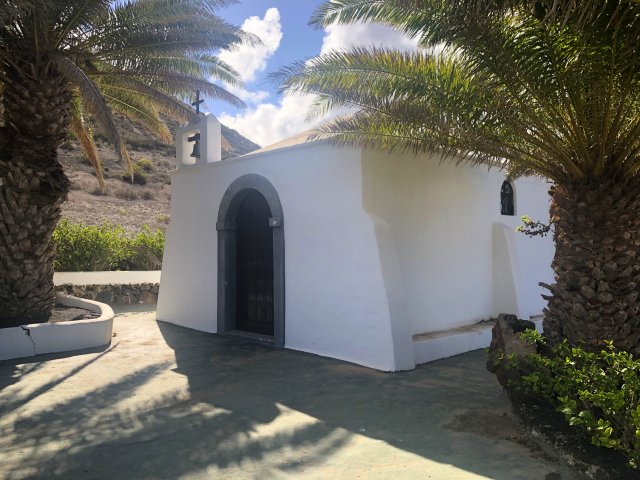
In Guinate is the beautiful little Chapel de Nuestra Señora de Lourdes. The west-facing building is completely whitewashed and has a wooden arched portal on its east side, which is framed in relief with gray basalt. The two impost stones left and right at the beginning of the arch reveal the builder's love for detail, as does the small espadaña with its three cones - an element that is often found at buildings of Lanzarote. The hipped roof is furthermore set back from the outer wall, which also gives this building a very special appearance. Similar to the church in Tabayesco, the buttresses give the facade a trapezoidal shape. To the left of the choir, i.e. on the south side of the building, there is a small sacristy attached. Remarkable is the westward orientation, this is probably due to the plot, the entrance points in the direction of the small village of Guinate, unlike if the chapel would be oriented to the east. However, the easterly orientation lost its great importance since the times of the Renaissance.

The Ermita of Orzola is located in Orzola, the northernmost village of Lanzarote. To what extent this church is consecrated to the patron saint Santa Rosa de Lima is unfortunately beyond my knowledge. Santa Rosa was a Peruvian virgin, mystic, and Dominican terciary. She is venerated as a saint by the Roman Catholic Church. Her commemoration day is August 23rd and the Orzola Fiesta also takes place in August - in her honor. It is a simple, rectangular building with a hipped roof and a round arched portal without any frills, except for the two street lamps to the left and right of the facade and the simple, small round arched espadaña on the right side of the facade. The east-facing building was built without buttresses, but it has a sacristy attached to the north side with very modern-looking windows. Unfortunately, I have no information about the year of construction, but it is very reminiscent of the church of Muñique, so I assume that it also dates from the 20th century.
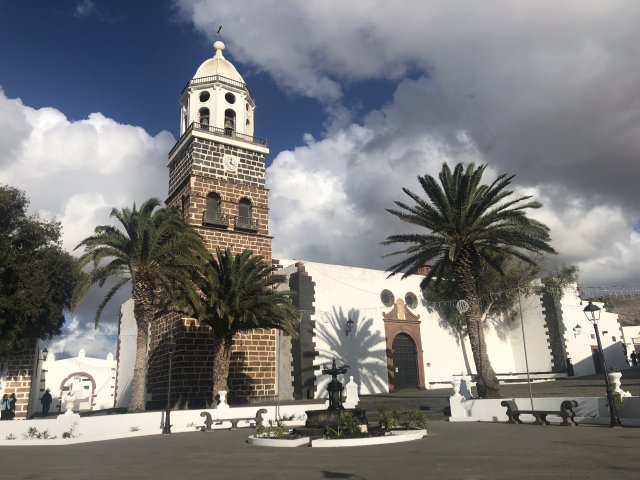

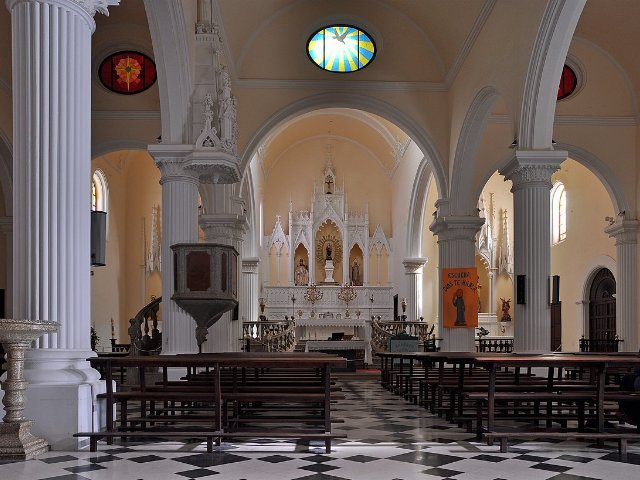
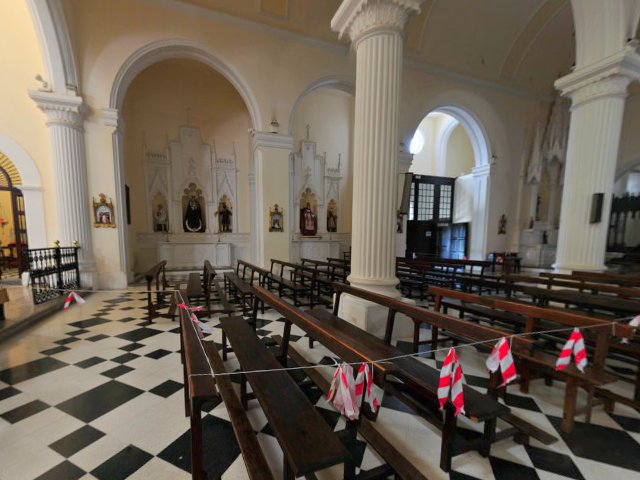

In Teguise, the former capital of the island, we find several churches. First of all, the parish church of the city, Nuestra Señora de Guadalupe, located directly on the Plaza de Constitución Square, even if many visitors of the Sunday market in Teguise know this square as “Lions Square”, named after the two stone lions that can be found there. The Virgin of Guadalupe is the patron saint of Mexico and above all the most highly venerated Marian figure in the entire Latin American region. The church was originally built as a simple building in the 15th century after Teguise became the island's capital. In the following centuries it was destroyed several times by fires, looting and pirate attacks, for example, during an invasion in the 16th century, the image of the Virgin of Guadalupe was captured and kidnapped to Algiers, but at least the head of it was later brought back to Lanzarote. In addition, the church once housed the image of the Virgen del Carmen (the patron saint of fishermen), which was unfortunately destroyed by fire in 1909. The current building is the reconstruction after this fire of 1909, in which the church was destroyed except for the outer walls and the lower three floors of the bell tower. This high, horizontally structured campanile is very remarkable about this church. One can clearly see its different building eras over the centuries. With its white dome, it became the symbol and essential distinguishing feature of the city of Teguise. Inside, the church reveals its structure as a three-aisled hall church, the naves of which are each covered with a barrel vault with belt arches over the column axes. Together with San Ginés Obispo in Arrecife, these are the only two real three-aisled churches of Lanzarote. During the last reconstruction, the barrel vaults replaced the original coffered ceiling inside the building. A series of chapels adjoins the side aisles. The transverse walls of these chapels are able to absorb the horizontal thrust of the vaults, similar to what is known from baroque wall-pillar basilicas in Central Europe. In addition, this construction is somewhat reminiscent of the Cathedral of Ibiza, even if the latter was just built as a single nave church. The fluted, white, neoclassical columns that support the round arches of the central nave walls are surprising and very atypical for Lanzarote. The church has a transept, which is separated from the naves by three triumphal arch-like partition walls with elliptical oculi placed above in the middle, as well as a step in the floor, very similar to the church of San Ginés in Arrecife. The last pair of columns consists of a bundling of four half-columns, a more formal design element, as they carry the same load as the other columns, but this is supposed to make the transept more easily recognizable.
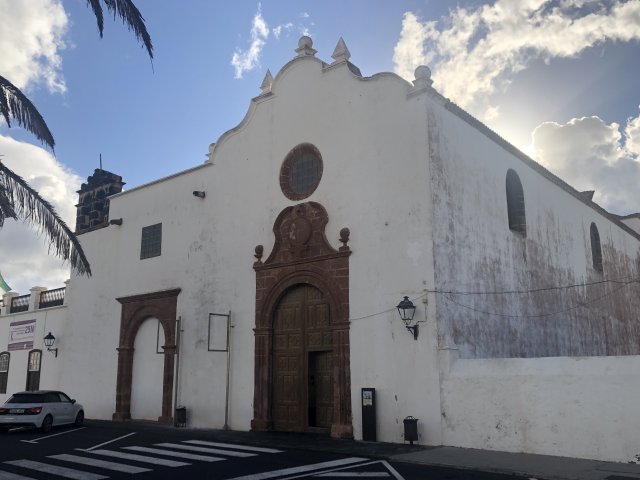


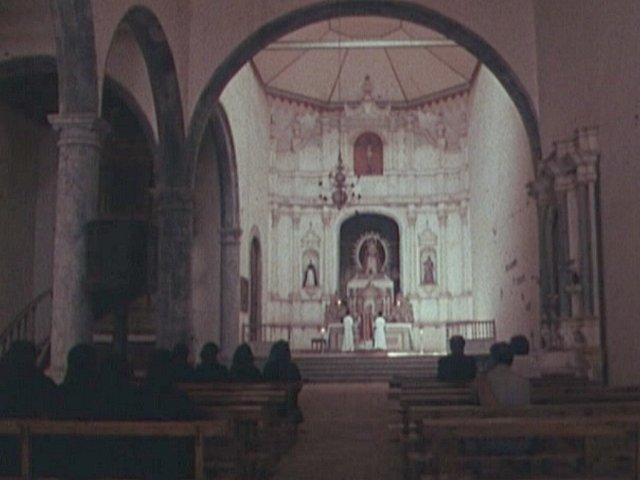
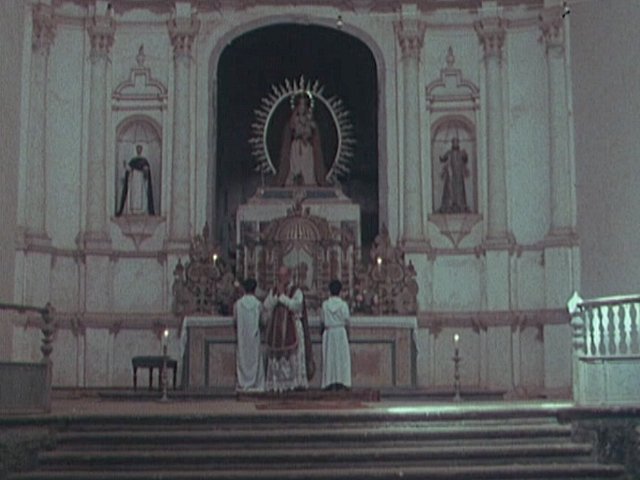
Right next to the town hall there is the former abbey church of the “Convento de Santo Domingo”. The Convento de Santo Domingo is a former Dominican monastery dating back to the 18th century. The convent building now houses the town hall, while the actual church “San Juan de Dios y San Francisco de Paula” is used by the city of Teguise for cultural purposes such as temporary exhibitions. It is a two-aisled church building, which was originally built in the 17th century. The facade of the main nave shows itself in a baroque robe with its entrance portal and its curved gable, while the left aisle, which also has a portal, is built as a simple, rectangular structure. Obviously these two ships were not built at the same time, but I have not found any information as to which of them is the older. Like all churches in Teguise - with the exception of the parish church Nuestra Señora de Guadalupe - the roof is covered with monk and nun tiles. Inside, the two unequal aisles are separated by a series of basalt stone columns with capitals made of the same material. A partition wall resting on round arches rises above it. The church has no transept, the choir room is simply in the right, longer nave and is now separated from the actual nave by a flight of stairs and a triumphal arch-like partition wall, as is also known from other multi-nave churches on the island, such as San Ginés in Arrecife, Nuestra Señora de Guadalupe also in Teguise or Nuestra Señora de los Remedios in Yaiza. In 1988, during a renovation, the multi-colored ceiling of the sacristy was unfortunately torn down, as well as the original ceramic floors, the altarpieces, the stairs of the pulpit and the “false domes” of the vestidor (changing room) of the Virgen del Rosario, the walls of which were adorned with allegorical frescoes. However, an ossuary was discovered under the vestidor of the Virgen del Rosario, in which over 100 skeletons were discovered, some of which were mummified.
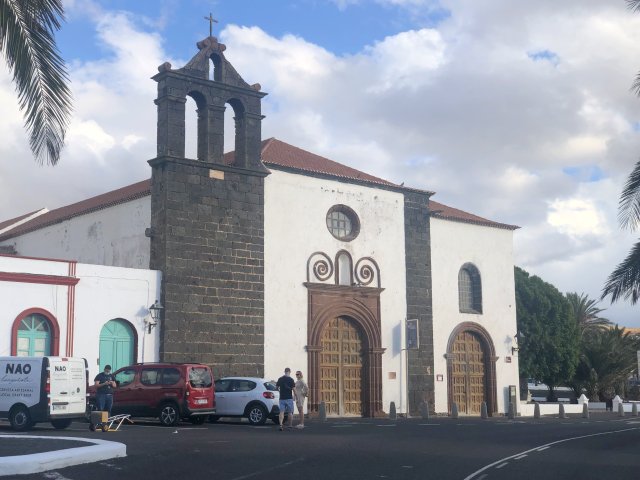
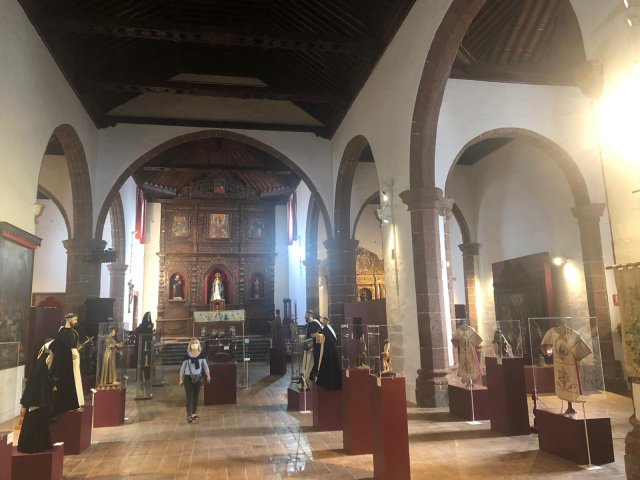

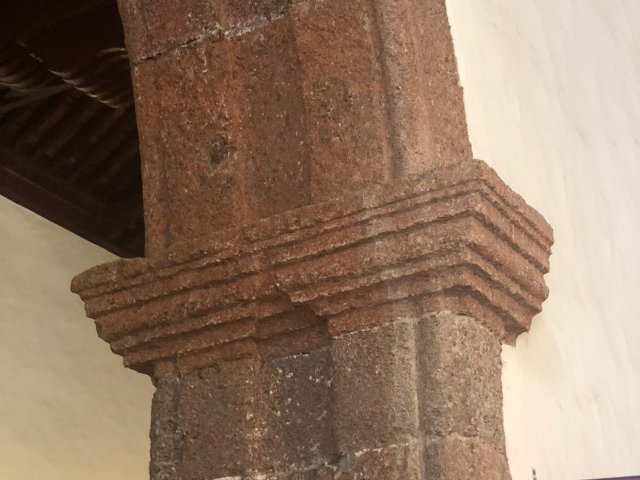
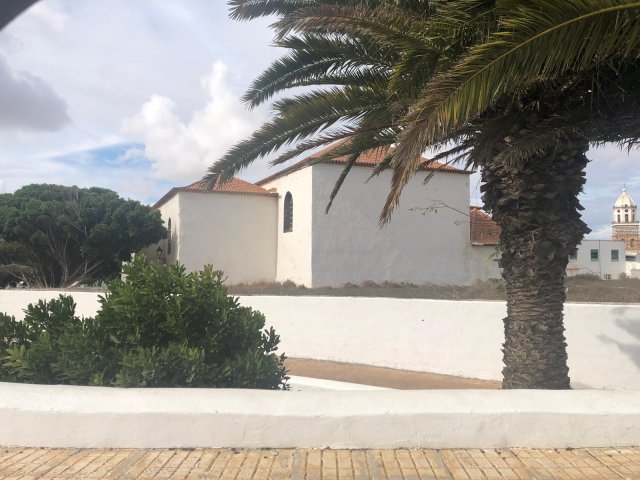
A few stones throws north of it is the beautiful, former Franciscan monastery Convento de San Francisco with its abbey church Nuestra Señora de Miraflores from the 16th century. The really impressive building, like many other churches in Lanzarote, also has Mudéjar style elements. The decoration, consisting of two volutes and a small round arch niche, above the wooden entrance portal, which is framed by archivolts made of red basalt, is striking. As with the Convento de Santo Domingo, the second nave has its own, somewhat simpler facade with its own portal - it is also a two-aisled church with a transept, which is structured in a similar way to the other multi-aisle churches of Lanzarote. Here, too, a triumphal arch-like partition separates the nave from the transept. The elaborately designed, open roof structure is very reminiscent of that of San Ginés in Arrecife and here, too, one speaks of a Mudéjar construction, albeit with the doubts already mentioned above. The building now houses a "Sacred Museum" - a large number of very Catholic-looking figures and other objects are exhibited here. The entrance fee is two euros and I would like to take the opportunity to say that this is not the reason for my interest in sacred buildings. Personally, I am interested in the history of architecture and this is best to study - worldwide, in every culture - considering the sacred architecture.
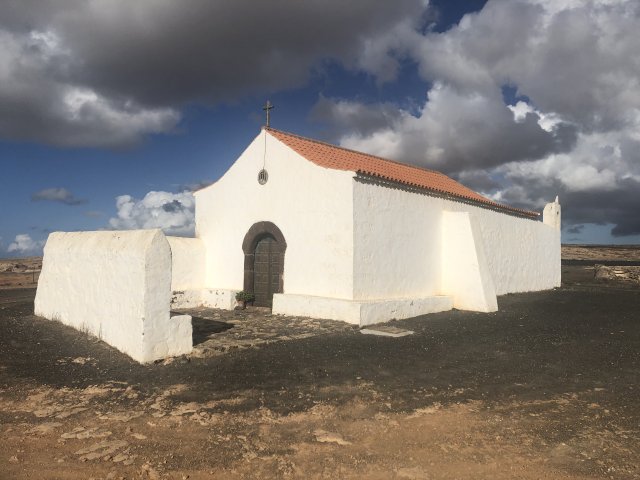


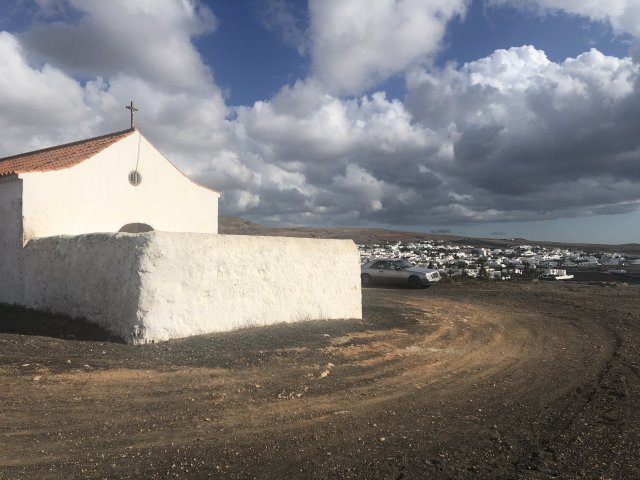
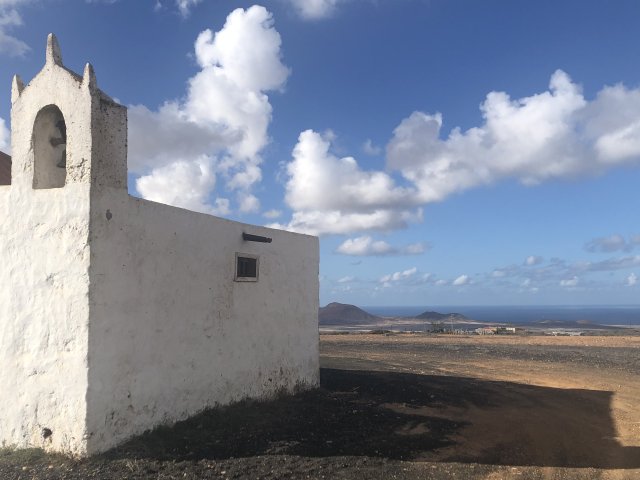
The Ermita de San Rafael, which already was founded by Maciot de Betancourt in the early 15th century, is located a little outside of Teguise, and situated majestically on a hill with a wonderful all-round view including of the ocean, even if the building has not been documented before 1674. So one doesn't know exactly when the building actually was built. It is also said that inside the small church should be a Mudéjar ceiling. The entrance forecourt of the single-nave building is surrounded by a wall, typical of a Lanzarote Ermita. The entrance is situated on the side facing away from the village, as the east-facing church is located northwest of Teguise. Exactly the opposite of the previously described Chapel of Nuestra Señora de Lourdes in Guinate. This speaks in favor of a construction period still in the already ending Middle Ages (15th century). The location also speaks in favor of an early year of construction: It is a real place of power, nobody would let a building go neglected in such a place, even if this is a sentimental and unscientific assessment. It is a very simple, but at the same time very beautiful building. It is covered by a hipped roof, which is flattened just above the eaves and which has a visible gable on the entrance side. The roof is, and this is very unusual for our island, covered with monk and nun tiles, even if this roofing certainly dates from a later period. This, together with the shape of the roof, gives the church its very own character. The entrance front has a central, wooden arched portal which is framed by red-brown basalt. Above that there is a small oculum and - on the roof gable - a small cross. The side walls each have only one buttress in the center. A sacristy with a flat roof is built on the east side and, above it, facing the town, there is also a small espadaña.
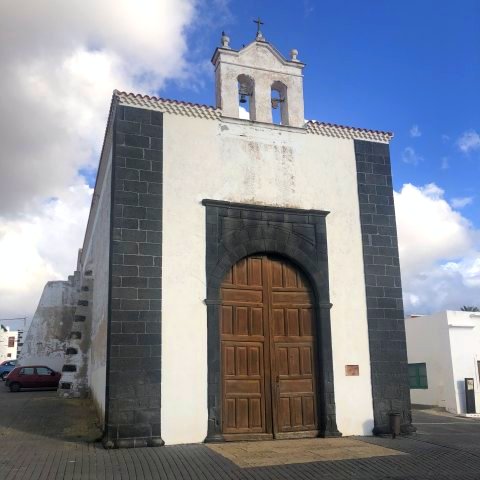
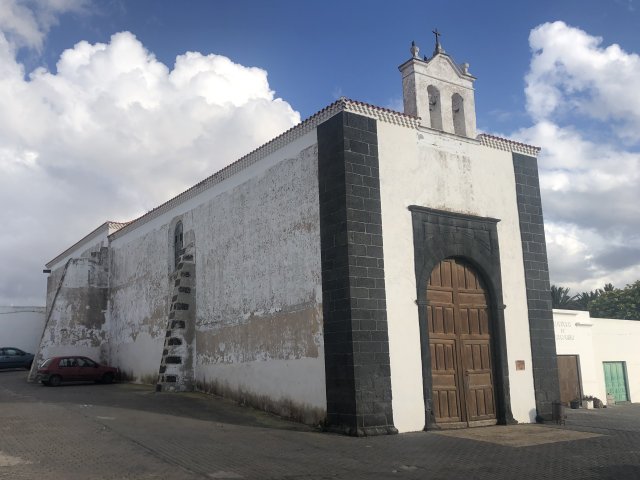

Another church in Teguise is the Ermita del Cristo de la Veracruz from the 17th century. The building is famous because it houses the crucifix of the Santísimo Cristo de la Veracruz, the most venerated crucifixion on the island Lanzarote. Unfortunately, the church is nowadays closed, but the interior is said to have a Mudejar-style coffered ceiling. It has a simple, rectangular floor plan, which is covered by a flat hipped roof, also covered with monk and nun tiles, which is slightly raised above the choir. A sacristy with a flat roof and a circumferential roof edge adjoins it in the east. The side walls of the building have striking buttresses. The equally rectangular main facade is framed by corners of the building made of black basalt. An espadaña is located in the very center above the high, wooden portal with a straight top. The symmetrical appearance of this church is very striking; it is repeated in Cristo de las Aguas church in Guatiza, which is said to have been built on the model of the Ermita del Cristo de la Veracruz. The building also played a role in the German television film “Die Quelle” (The source) by Rainer Erler, which was shot largely in Lanzarote in 1978.
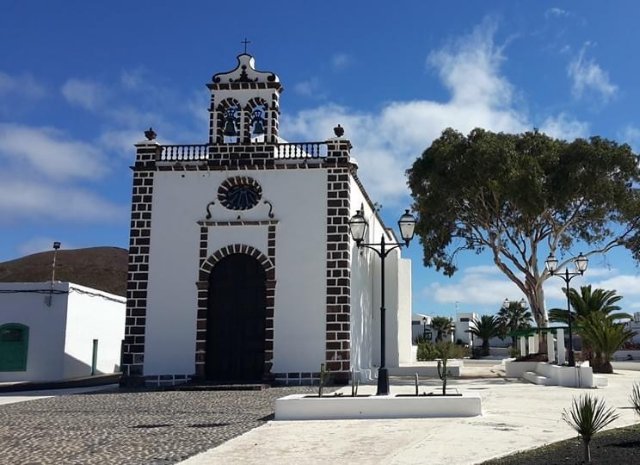

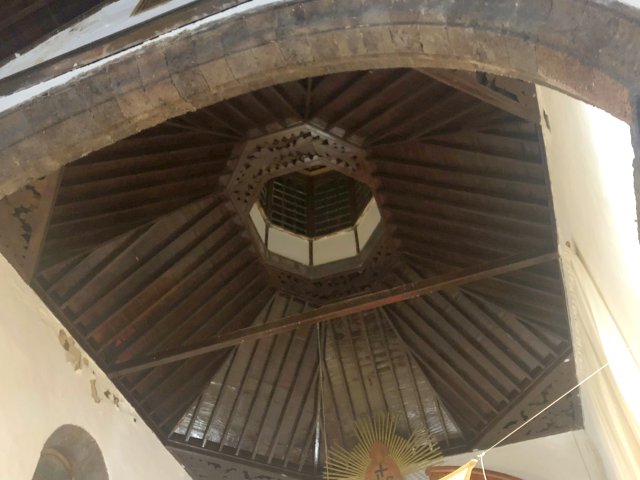
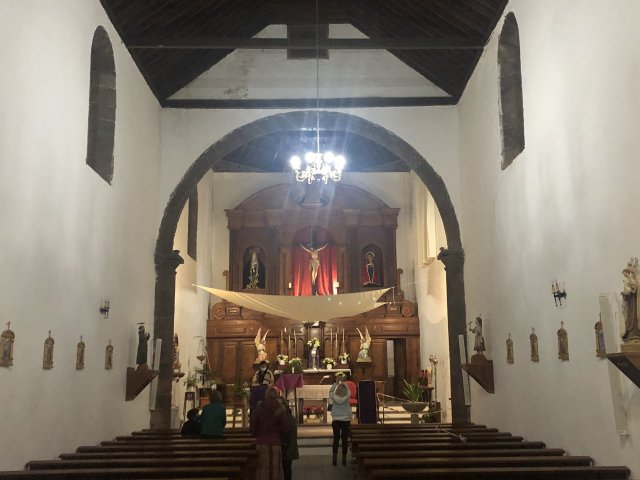

Guatiza also belongs to Teguise and has its own church, this is the Cristo de las Aguas church. The current temple was erected from 1869, but there was already a predecessor building which dates back to the end of the 17th / beginning of the 18th century. It is said that at this time, off the coast of what is now Los Cocoteros, a crucifix has been washed up in the bay of the Riadero. The rains that followed soon after were attributed to this crucified Christ - the island had not seen any rain for three years at this point. So the church that was built soon got the name “Cristo de las Aguas”, (Christ of the waters). The church building has a rectangular floor plan and was probably built on the model of the Ermita del Cristo de la Veracruz church in Teguise from the 17th century (see above), in which also a crucifix is venerated, the Santísimo Cristo de la Veracruz. The church has a Mudéjar-style ceiling, over the choir it is furthermore built as an elaborate tent roof with an lantern. During 2006 the building was damaged by the tropical storm "Delta", which caused even more damage to the island. The lantern, the espadaña as well as the entrance door were damaged.


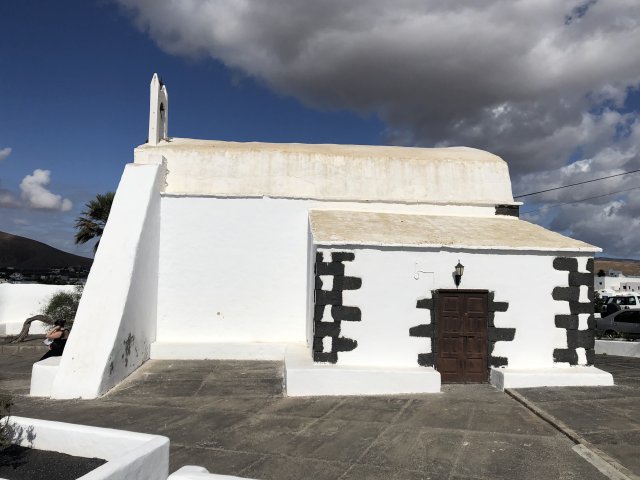
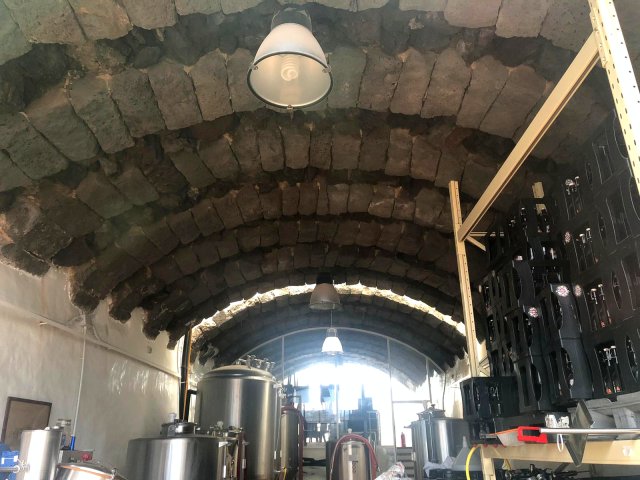
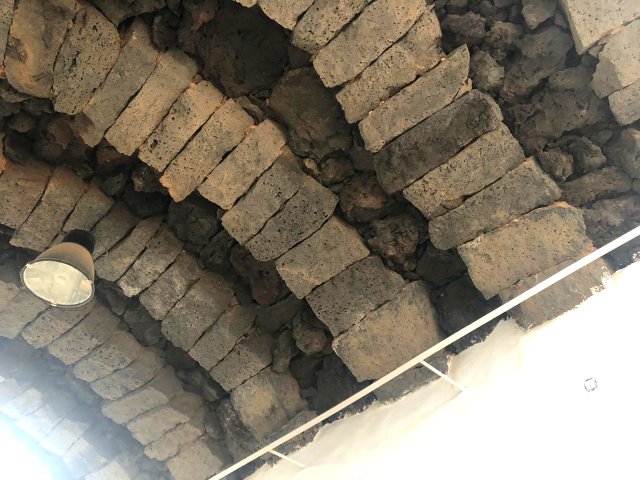
Tahiche is also a village belonging to Teguise with its own church from the 17th century, called Ermita de Santiago Apóstol. From the outside one can already see its mighty buttresses, they are necessary to absorb the horizontal thrust of the vault, because in contrast to most of the other churches on Lanzarote which have a wooden roof, this building has a barrel vault, one can already see this on the facade. Because of this design feature, it is a particularly beautiful church! On the south side, the sacristy is added between the second and third buttresses. In fact, the Lanzarote builders of the past were real artists when it came to erect vaults from mostly uncut lava stones. Hundreds of underground cisterns, so-called “aljibes” have such vaults. In the photos you can see the construction of such a vault, using the example of the cistern transformed into a restaurant called “Los Aljibes”, which is also located in Tahiche. While this is possible without any problems with an underground structure, with the Ermita de Santiago Apóstol in Tahiche it was only possible with great effort to introduce the horizontal forces of its vault into the earth - the external sign of this are the mighty buttresses on its side walls that give this building its special character.
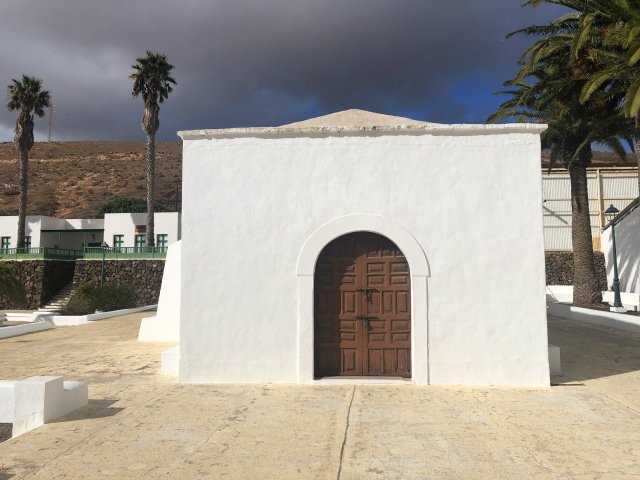


Of course, there are also churches in the other small villages belonging to Teguise, for example the Ermita de Santa Catalina, also known as the Ermita de San José, located in Los Valles. The building was built in the 18th century after the volcanic eruptions (1730-1736) by citizens who fled from Santa Catalina. Like many other church buildings in Lanzarote, the church also contains a Mudéjar ceiling. It is one of the few single-nave churches that have a real transept and whose floor plan was built on the basis of a Latin cross. The building is oriented to the north and a sacristy was added between the nave and the eastern arm of the transept. The nave has a hipped roof, while the transept arms and the crossing space are each covered by tent roofs, the latter being a little higher. What is particularly striking about this church are the mighty, sloping buttresses along the walls of the nave with their benches in between, which are typical of the island.
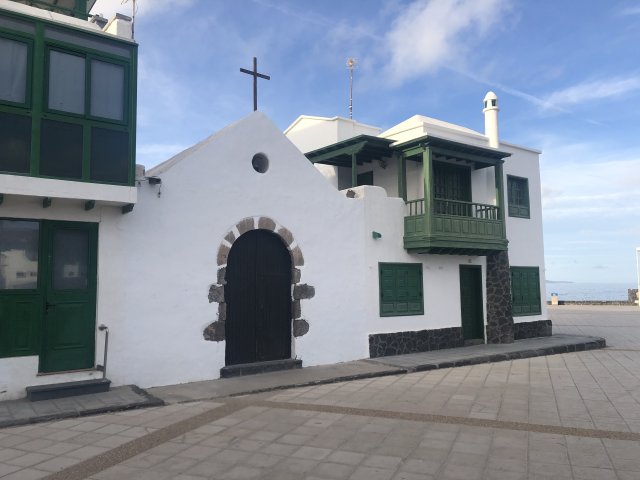
Caleta de Famara also belongs to the municipality of Teguise, it was once one of the three large indigenous settlements of Lanzarote. When Juan Betancourt and his Franciscan monks arrived in Lanzarote in 1402, the Ermita de Nuestra Señora de las Mercedes was built in Famara and the Franciscans are said to have stayed there for 33 more years. Their livelihoods were alms, agriculture and of course fishing. From the will of Sancho de Herrera from 1534 there is also known a clause that says: "I have the will that a monastery by brothers should be built in my garden in Famara". Nonetheless, the Ermita de Nuestra Señora de las Mercedes was destroyed in 1735, to be rebuilt in Mala in 1809 (see above). According to Wölfel, "Famara" is derived from "Famagui", which is supposed to correspond to a place name for Lanzarote. Navarro Artiles, however, says that "Famagui" emerged as a spelling mistake from "Famara". Meanwhile Carmen Díaz Alayón thinks, “Mara” as part of the word “Famara” is the same root as it occurs in the prehistoric place names “Autinmara” and “Dutinimara” from La Palma. To what extent there is an analogy between “Mara” (Famara) and “Mala” is not known to me. In any case, today's small church Iglesia del Sagrado Corazón de María was built at the end of the 19th / beginning of the 20th century, directly on the promenade of Famara. For their construction as well as for the construction of other houses lime was mostly used, which was produced in the bays of Famara. The place had at this time three houses, 24 warehouses and 25 residents. It is also reported that in 1909 a large number of visitors gathered for the celebrations of the Iglesia del Sagrado Corazón de María.
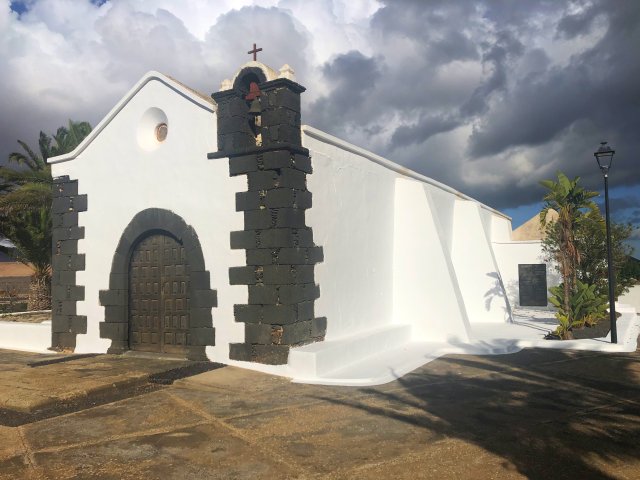
In Teseguite, also part of Haría, there is the church called San Leandro from the 17th century, which has inside a coffered ceiling in Mudéjar style, even if it was renewed at the end of the 20th century. At the same time, the building was also plastered, so that the original wall structure was unfortunately destroyed.
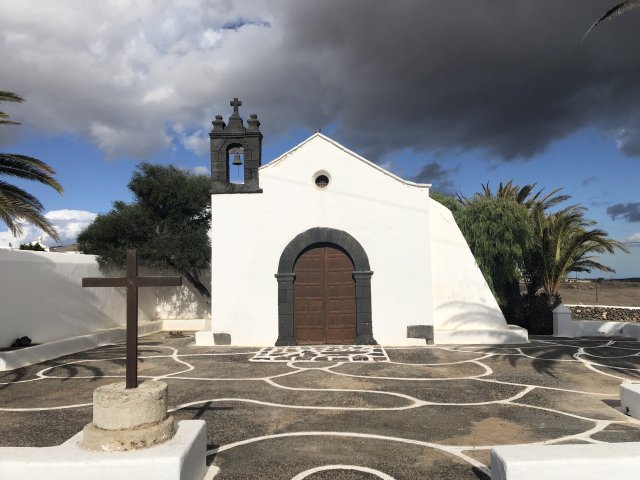
The small, picturesquely situated village of El Mojón also has its own enchanting church called San Sebastián. Like that of Teseguite, it was built in the 17th century and it is also said to have a Mudéjar ceiling inside. Outwardly, too, it is very similar to its “sister church” in nearby Teseguite.

The Ermita de Nuestra Señora de Nazaret is located in the municipality with the contemplative name of Nazaret, in the immediate vicinity of Teguise and only separated from it by the volcano on which the Castillo de Santa Bárbara is located. The church was built 1643-1648. It is a simple, single-nave church with a sacristy on the south side. A type of building that is very common on our island.

The municipality of Soo - today also incorporated into Teguise - was founded in the 16th century by the Moors during the African raids of Agustín de Herrera. The church of San Juan, built in the 18th century, is located there. The facade of the single-nave church with its hipped roof has something baroque about it, due to the eaves and the espadaña rising with a dynamic curve. Furthermore a tent roof with rounded shapes rises above the clearly elevated choir, which almost gives the impression of a dome. This roof shape can also be found often on Lanzarote. A sacristy is attached to the west side of the choir of the generally south-faced church. This Ermita was founded in the 17th century by Juan Gutiérrez Núñez and María de los Reyes because of their marriage, they also made ten bushels of land available for construction.

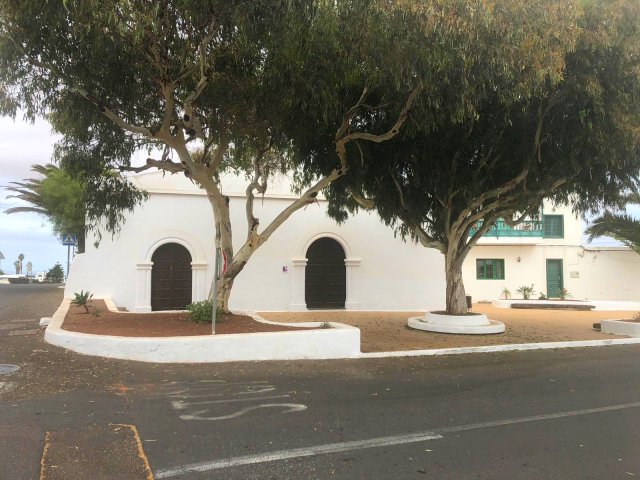
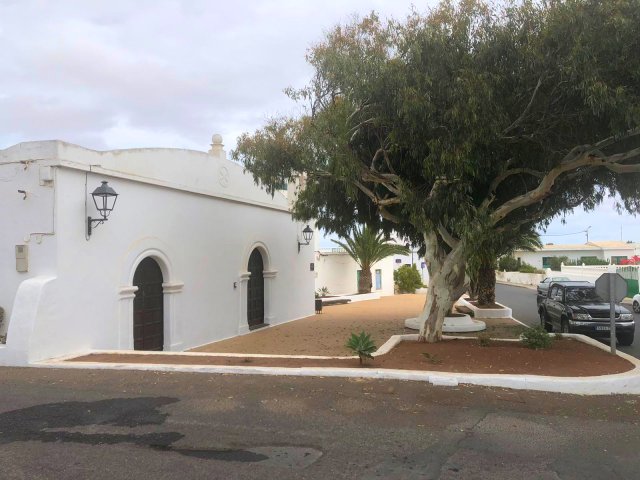
San Andrés in Tao was built in the 1st half of the 17th century. Tao is also part of the municipality of Teguise today. Before the volcanic eruptions of the 18th century (1730-1736), however, a distinction had to be made between the municipalities of Tao and San Andrés. Tao was more in the direction of El Jable, while San Andrés was on the hill that gave it its name. The two-aisled building is located at a wonderfully designed, small town square called “Plaza Juan Quintero”, whose trees shade nicely the church facade with its two entrance portals, so that it is almost impossible to take a photo of the beautiful building in its entirety.
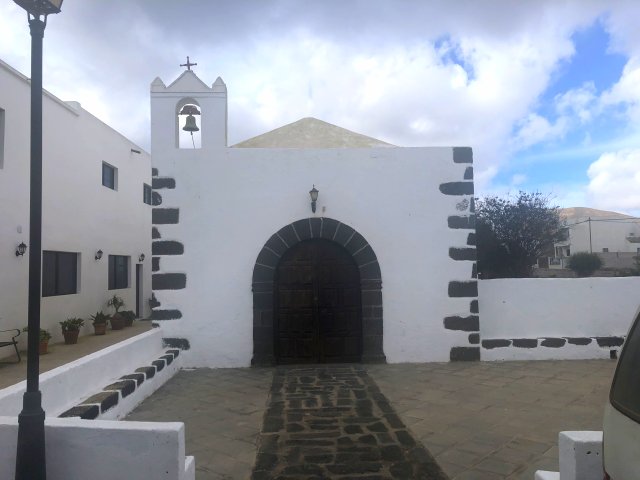
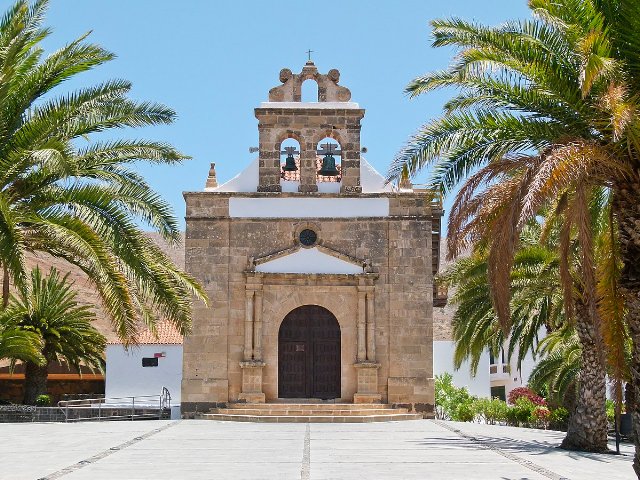

In Mozaga, which is as well a part of Teguise, we find the Ermita de Nuestra Señora de la Peña, built in 1785. The Virgen de la Peña is actually the patron saint of our neighboring island Fuerteventura, furthermore it is one of the oldest dedications of the Canary Islands beside the Virgen de la Candelaria. The image of the Virgen de la Peña is said to have been present in almost every house on Fuerteventura. It is also said that once a family moved from Fuerteventura to Lanzarote and brought the picture of the Virgen de la Peña with them, which is how it should have ended up in the hermitage in Mozaga. In 1793 she is said to have performed a miracle, she was able to heal the daughter of Fernando Pérez, who has already been given up by the doctors. There exists a painting of this miracle, a copy of which is in a private house in San Bartolomé, while the original is in the Iglesia de la Peña on Fuerteventura. In the hermitage of Mozaga there is also a very beautiful baroque altarpiece, but the jewel of this church is the alabaster painting of the Virgen de la Peña. It is also a simple, single-nave building with exposed masonry made of basalt stone at the corners of the building, while the arched portal also is framed by basalt. An espadaña rises asymmetrically above the left-hand side of the right-angled entrance façade. The building also has - typical for an Ermita - a small forecourt which is surrounded by a wall.
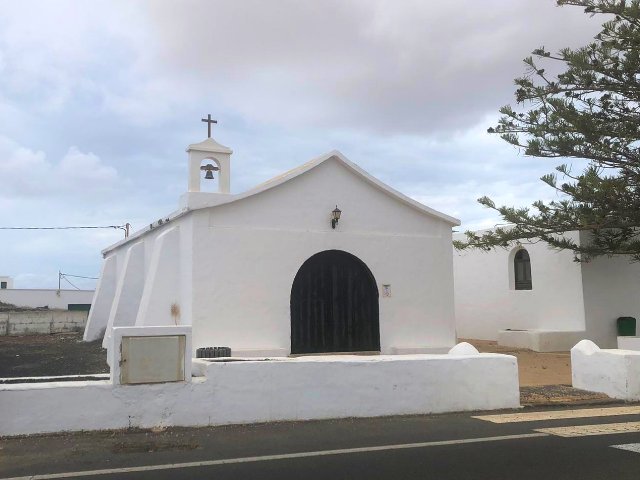
A community known only to a very few visitors to Lanzarote is Muñique, which also belongs to Teguise. There is the Ermita de Nuestra Señora Fátima, which was founded in 1972 by Doña Pilar Morales de León. The single-nave building has very distinctive buttresses, but this is more of a formal design element, as technology and building materials were already available due to the year of construction to build such a building without buttresses. There is a small arched window always between two of the buttresses, and the portal on the entrance side is also provided with a rounded arch, but without any framing made of other material. An elegantly curved gable roof rises above the building, and the espadaña is asymmetrically located above the entrance facade on the left. The building is oriented to the west. Another feature of the entrance facade is the ledge on which the gable wall is bricked up - it is obviously a little thinner than the wall on the ground floor below.
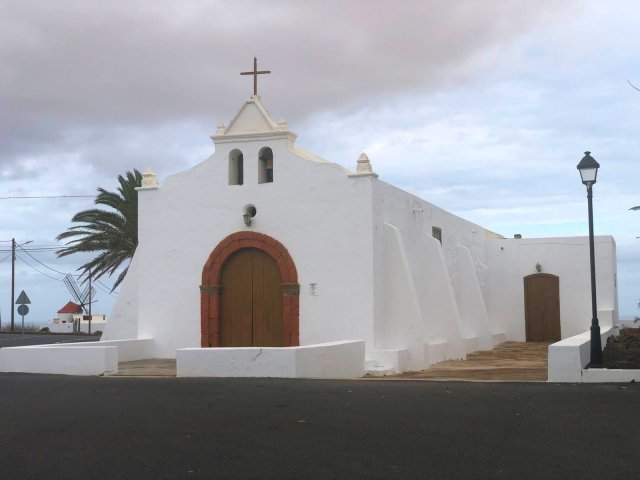
Last but not least we have another church in Tiagua, also in the municipality of Teguise, which is called Ermita de Nuestra Señora del Socorro. It was built in the early 17th century. Its facade, which is slightly curved at the top, also has something baroque about it. The espadaña of this church is furthermore not attached, as in many other examples, but integrated into the facade.
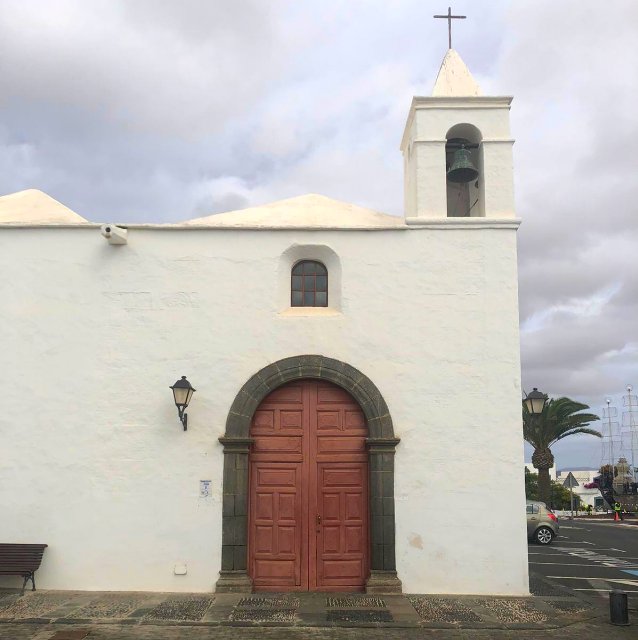
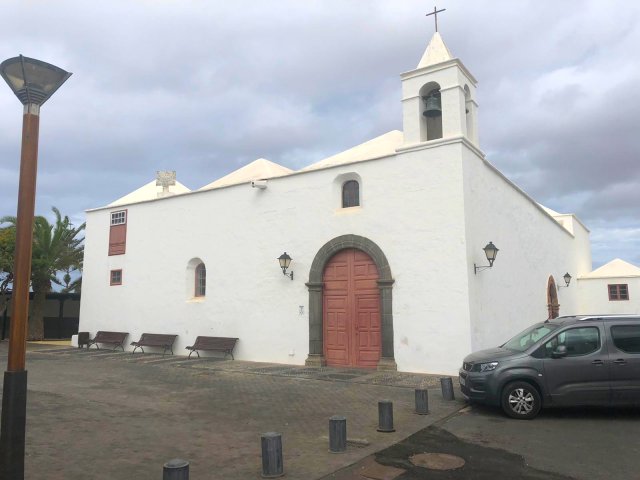

Tinajo is an independent community in the west of Lanzarote and of course we can also find a church there, the Iglesia de San Roque from the 2nd half of the 17th century. The building, which faces north-east, consists of two different sized naves - a motif that is often seen on Lanzarote. Both of which are covered by a hipped roof which is raised in the area of the choir room. The arched portal, framed with basalt, is located in the main facade of the right, larger of the two naves. There is also a small bell tower on the right-hand corner of the building. On the facade there is also a sundial from 1851. In addition to the two naves, the church consists of a sacristy, warehouse, baptistery and a small chapel. The floor of the choir is raised opposite the nave and also separated from it by a balustrade. In the roof level, too, the choir room is spatially separated from the nave by a triumphal arch-like partition wall, which extends over both aisles. The building also has a Mudéjar ceiling which is supported by a series of round arches over Tuscan-style columns made of reddish-brown basalt. The side walls of the church were erected without buttresses, this was made possible by wooden, transverse tension beams in the ceiling level, which absorb the horizontal forces of the roof structure. This motif - I mentioned it above - suggests that the roof structure was not erected by Mudejares but by local carpenters who were inspired by Islamic architecture. This remains an open question for many Lanzarote churches.

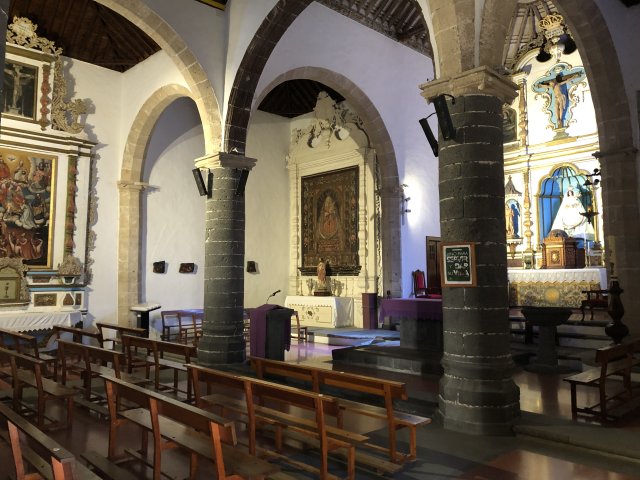

Yaiza is the main town in the south of Lanzarote, the tourist town of Playa Blanca, for example, belongs also to this municipality. The Nuestra Señora de los Remedios church is located in Yaiza. It is a two-aisled church, we have already seen this in several examples, but above all, this church is very reminiscent of that of the Convento San Francisco in Teguise - in all probability it was even built after the model of Teguise. One of the two ships was probably built in the 17th century while the second was added in 1728. In the facade of the left of the two naves is the main portal with another arched window on the upper floor, while the right of the two naves is crowned with a baroque-style espadaña above its windowless facade. The right aisle also has a second, side entrance portal. Both naves also have a tiled hipped roof, which is raised above the choir, just like the church of the Convento San Francisco in Teguise. Inside, the naves are separated by a series of columns with capitals made of basalt, typical for the island, and here, too, the choir is spatially separated from the nave by a triumphal arch-like partition wall. The interior of the church is also very richly decorated, the painting of Nuestra Señora del Rosario from the beginning of the 18th century is particularly noteworthy. Both naves are closed at the top with a Mudéjar ceiling.
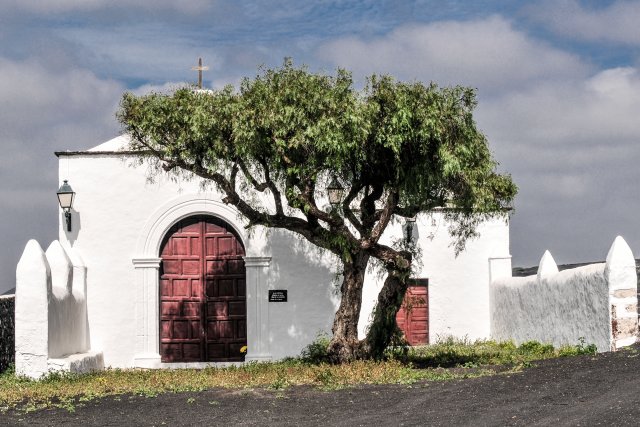
The Ermita de Caridad, the Hermitage of Our Lady of Charity, is located in the middle of the La Geria wine-growing region, directly opposite the Bodega Rubicon. Some sources give 1706 as the year of construction of this small church, but according to other sources it was not built before the middle of the 19th century. It is a single-nave, simple building with a hipped roof, it is oriented to the northeast and has a sacristy attached to the southeast. Typical for a Lanzarote Ermita is the surrounding of the forecourt with walls. The entrance facade has a central, wooden arched portal, which is framed by a frieze consisting of pilasters with capitals. This motif could also have been the model for the entrance portal of the church of Montaña Blanca. In the middle above the entrance portal there is an espadaña which is crowned by a cross.
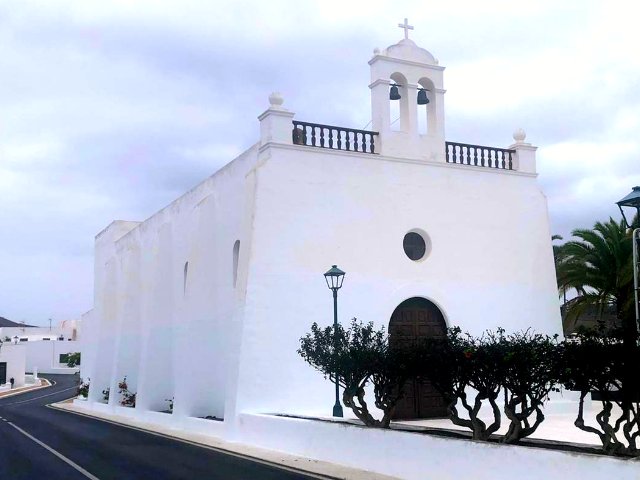
San Isidro Labrador is located in the municipality of Uga, known to many for its salmon smokehouse. The building is built strictly at right angles, facing north and has tall, slightly sloped buttresses on the left and right of the side walls. A sacristy is built on the north side, the height of which does not reach the main building. In the middle of the entrance facade there is a round arch portal, which is also comparable with the two portals of the Ermita de Caridad and the Ermita de Maria Auxiliadora. In the middle above it there is an oculum, while the upper end is formed by the symmetrically arranged espadaña. The roof edge is decorated with a balustrade, this is very unusual for a church on Lanzarote, but the building has a flat roof so a balustrade makes absolutely sense.
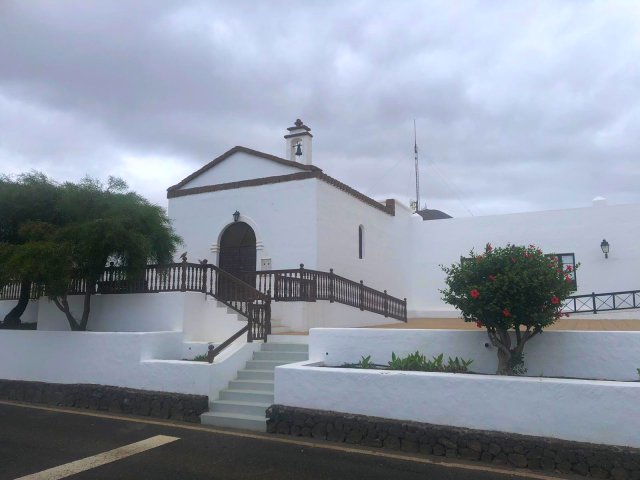
The Iglesia de San Luis Gonzaga is located in the very tranquil and rural town of Las Breñas, also incorporated into Yaiza. It is a very simple, single-nave building, which has a tympanum-like gable above its entrance facade in addition to the arched portal typical of the island - behind it, however, there is simply a flat roof. The pompous staircase that leads from street level up to the church is furthermore a striking element.

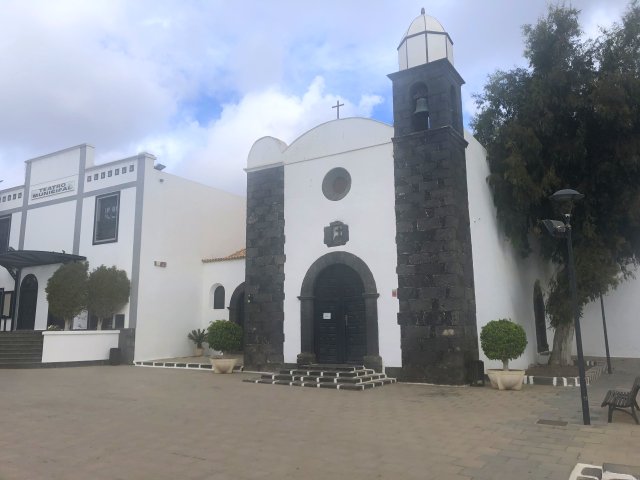
The current parish church of San Bartolomé was built in the years 1779-1783, about 200 meters from the original Ermita which became too small. The building also has one of the few church towers on the island, which is covered with a small cimborrio (dome). The church was restored several times during the 20th century, and the small chapel was added to the left, which even has its own entrance from the Plaza de León y Castillo. However, one should not believe that the high town hall tower of San Bartolomé, which stands directly next to it, would belong to this church, because it is a secular building. In this way this ensemble reminds a little of Don Camillo and Peppone...
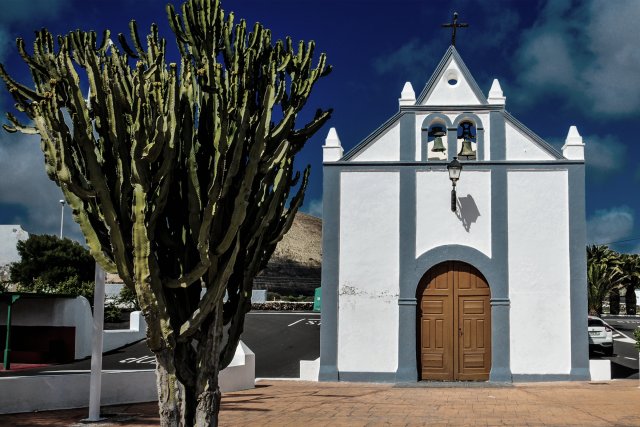
Güime is a district of San Bartolomé, and of course here we also find an own, small church. It is the San Antonio of Padua church which was built in 1913. It is a very unusual building for Lanzarote, the facade of which is decorated with a frieze of pilasters and cornices. The espadaña is symmetrically integrated into the gable wall.
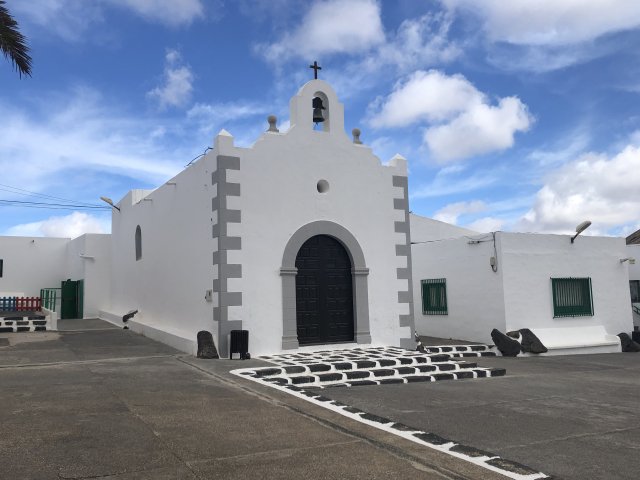
Montaña Blanca is a small village that belongs also to San Bartolomé, and here, too, we find a small church, the Ermita de Maria Auxiliadora. The building was built during the first half of the 20th century. It is a single-nave, rectangular building with a hipped roof. It faces northwards and has a sacristy attached to its east side. The entrance facade is very nicely designed, it ends at the top with several sweeping curves, which tower up to the centrally arranged espadaña. This facade also has a somewhat baroque character and probably takes up this theme from the two churches in Soo and Tiagua, although these two buildings date from the 18th and 17th centuries. The centrally placed entrance portal is framed by gray basalt in the form of two pilasters. The two impost stones on the left and right, at the beginning of the round arch, are also very beautiful. The corners of the building are also visually highlighted with natural stone masonry made of basalt, even if it is likely to be blinded.
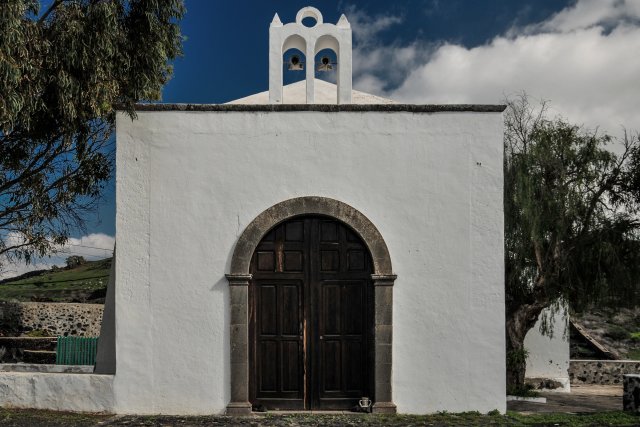
The Ermita del Corazón de Jesús in Tegoyo was founded in the 18th century by Mariano Stinga Paturso and his wife Andrea Rodríguez Curbelo. Mariano was a merchant sailor from Sicily descending from a Polish family. When he arrived on Lanzarote, he married the young Andrea, daughter of the Mayor of Haría who also was the Lord Mayor of the island at the same time. Mariano himself took over the office of the deputy mayor of Arrecife and he also became mayor of Tías (... ;) The rectangular, simple building is very beautiful. An espadaña rises symmetrically above the entrance facade, above the portal in the style of the Ermita de Caridad. The building faces eastwards and has a sacristy attached to its south.
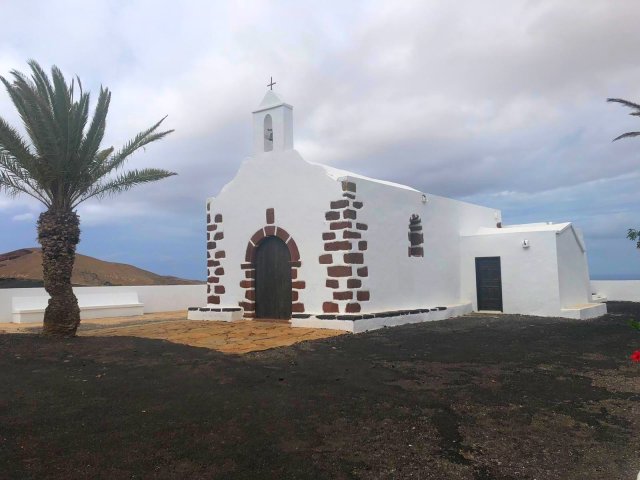
In La Vegueta is the Ermita de Nuestra Señora de Regla, the church was built towards the end of the 17th century. According to various sources, the very dark altarpiece of the Virgen de Regla was either found on the beach in front of Lanzarote, or it came from Cuba and was brought to Lanzarote by a migrant from there. The north-facing building has a gable roof which is hipped on the north side. A sacristy is also built there. The facade is curved in several curves at its upper end, with an espadaña in the middle above it. We already know this baroque facade motif from several churches here on the island. The wooden arched portal is framed by exposed brickwork made of red basalt, and the corners of the building are designed in the same way.
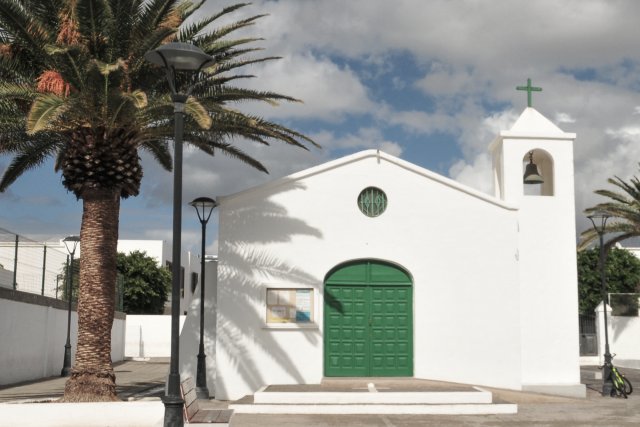
Some time ago, the parish church of Santa Elena in Playa Honda was checked to see if it should be demolished and replaced by a new one. How far this project has come, however, is beyond my knowledge. The previous, single-nave structure faces northwards and has also a small bell tower. A sacristy is built on its east side. The entrance portal is painted in Lanzarote - green, the only church on the island that uses this color for doors and windows. Just like the church in Tabayesco, the arch above the entrance door has the shape of a three circle arch (basket arch) - although it is not a pointed arch as in Tabayesco.
Without further information, just for the sake of completeness, I would like to mention also the following church buildings:

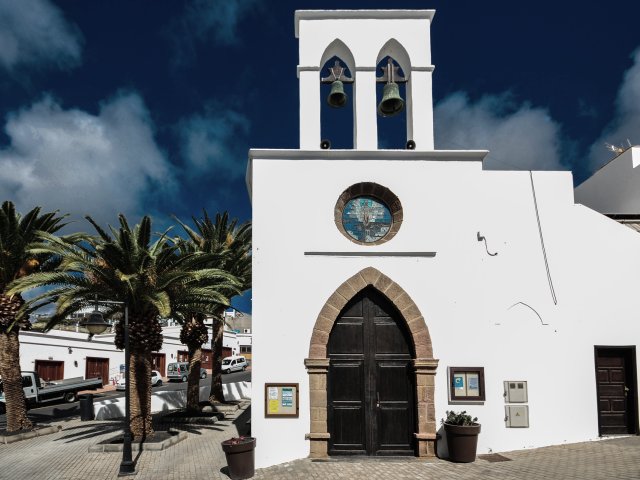


The Ermita in Macher (2nd row, right photo), in the village of the same name is no longer used as a church, the building looks abandoned from the outside. It was probably too small as a church, and the newly built San Pedro church directly on the main street took over its function.
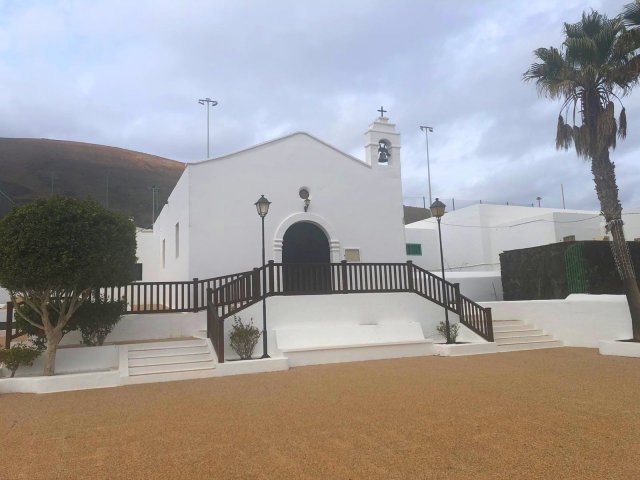
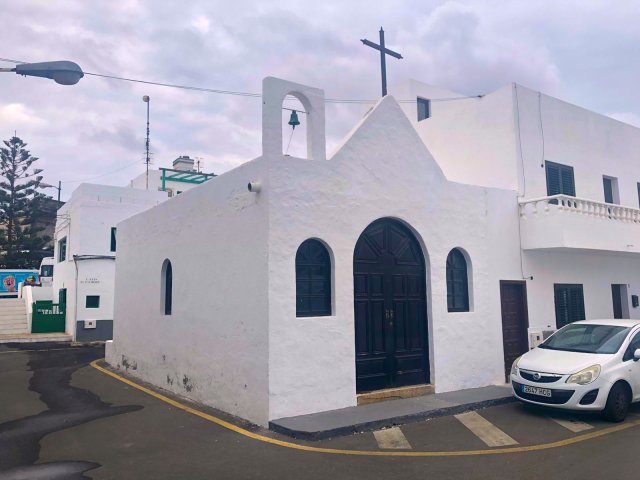
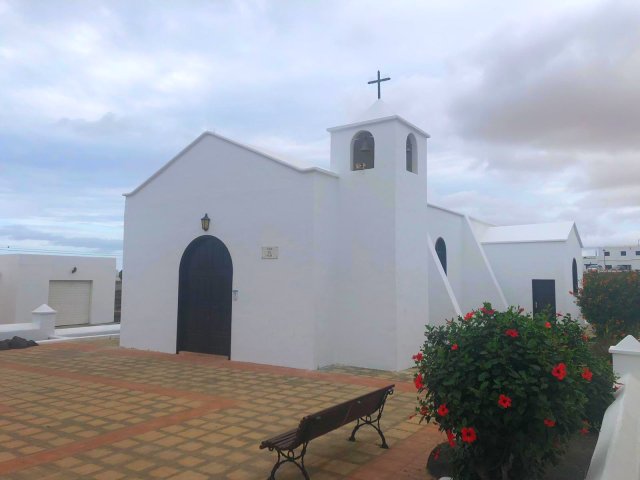
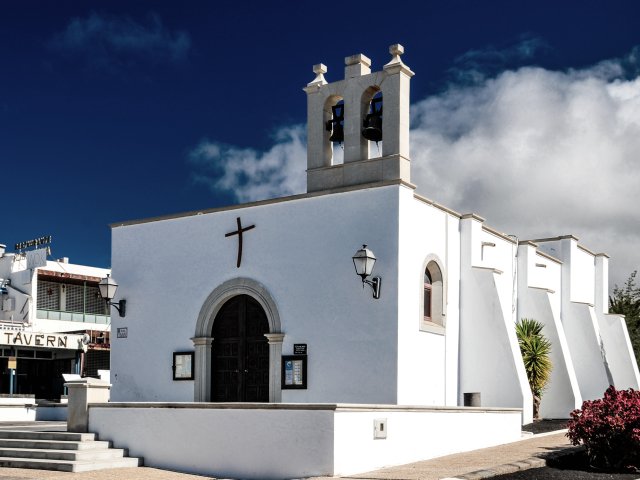
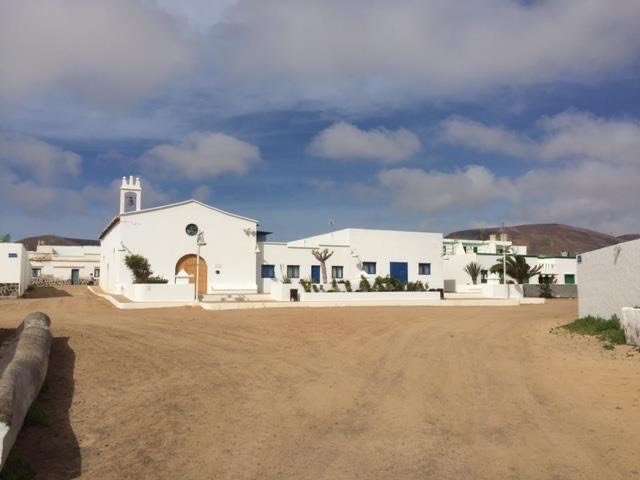
Although La Graciosa belongs not longer to Lanzarote for two years, but has advanced to become an independent, the eighth island of the Canary Archipelago, which is now managed directly by Las Palmas, I would like to mention Nuestra Señora del Carmen there, as La Graciosa is for the people living on Lanzarote still a part of “their” island. The small church in Caleta del Sebo, the main town of La Graciosa, was built in 1945.
Style elements




Espadaña, Fair-faced masonry and arched portal made of basalt stones, buttresses, mudéjar ceiling
Lanzarote's church buildings are - with a few exceptions - more or less all built in a similar architectural style. Most of them are single-aisled, but some of them are also two-aisled buildings with plastered, white-painted outer walls. Many of them also have buttresses on their side walls and a sacristy attached to one of their side near the choir. Often there are also stone benches built between these buttresses. As a rule, the churches have a wooden arched portal, the border of which is normally bricked with basalt stones. Often one can also see exposed masonry made of basalt on the edges of the building or on the buttresses. Only a few of these churches have a bell tower, mostly one can just see an “espadaña”, a bell tower-like structure above the entrance facade, as is also known from many Mediterranean churches. The “Ermita” churches (hermitages) are usually surrounded by something as a “garden-wall”, at least the entrance area, that’s simply because of wind protection reasons. Inside, the buildings are often kept very simple and many of them have an open, wooden roof structure, which was either inspired by the Mudéjar architecture of the Moorish builders or even built by themselves. Very rarely one can see vaults or domes. In multi-aisled churches the arched arcades of the central nave walls normally rest on columns made of basalt, with simple capitals made of the same material.
Buttresses

Buttresses
Before starting, just a word about the buttresses: Perhaps someone asks why particularly the older, small churches have buttresses on the outer walls, even though they have such thick walls and, in comparison, to carry only a very light, wooden roof. But basically gable or hipped roofs are built on the Canary Islands - even today - according to the principle of the “rafter roof” (that's how we would call it in Central Europe). This means that a horizontal thrust is created via the rafters, which pushes the outer walls outwards at their top. But especially the older buildings with their thick walls are made of “piedras” (volcanic stones), which were normally walled up without mortar, at best clay was used as a kind of mortar. Of course, such a wall cannot absorb any horizontal force at its upper end, the volcanic stones would simply be pushed outwards, or with every small earthquake the top of the wall would move a little outwards until the roof finally collapses. The buttresses are there to prevent this from happening.
Ermita de las Nieves



Ermita de las Nieves, Santa Maria Maggiore in Rome with parallels in the history of its origins - photo: Wikimedia
Already at the time of the conquest of Lanzarote by the Spaniards during the 15th century around 20 hermitages (Ermitas) were built on the island. Unfortunately, nearly nothing of these buildings has survived, even if some of them have been rebuilt. One of these temples is the Ermita de las Nieves church which was built from 1423 on the Risco de Famara mountains, above the famous Famara beach. It is probably one of the most emblematic churches on Lanzarote. In the book "Nuestra Señora de las Nieves" (Our Lady of the Snow) one can read how the building was destroyed and razed to the ground during a pirate attack in 1576. During the 17th century it was then reconstructed again, after the place had been abandoned for more than 100 years. Some renovation work is also documented for the year 1710. After the volcanic eruptions of the 18th and 19th centuries, during which the Virgen de los Dolores (“Virgin of Sorrows”) rose to greater importance, the Virgen de las Nieves reappeared a little forgotten and the church building was again exposed to neglect. In 1966 the remains were finally torn down and a new building was erected by the architect Henry Spínola from Teguise. The only thing that has been preserved is the old cistern (aljibe) on the site, which can still be seen today. The rectangular structure is covered by a hipped roof to which a tent roof is attached above the choir room. The church is not oriented to the east but more or less to the north, so the sacristy attached to the side of the choir adjoins on its east side. The buttresses along the side walls are very typical of Lanzarote churches. The entire complex is also surrounded by a wall, which is, on the other hand, typical of an Ermita. The Virgen de las Nieves was declared to be the patron saint of Lanzarote in 1725 (this was before the volcanic eruptions of Timanfaya), after having been venerated and worshiped for rainfall since the 15th century - according to legend, it once heralded a significant snowfall which should take place during an August, so a pilgrimage to this hermitage takes place until today every 5th August. To what extent such legends have a real core is of course questionable, but in this case one inevitably has to think of the genesis of the early Christian church of Santa Maria Maggiore in Rome, because here too it snowed on a 5th August, but as early as 352 AD...
Mancha Blanca, Nuestra Señora de los Dolores





Mancha Blanca, Nuestra Señora de los Dolores, barrel vault over the main nave, pendentif dome over the choir, at the bottom right one can see the baroque altar with the statue of the Virgen de los Dolores.
In Mancha Blanca we see the Ermita y Santuario (Sanctuary) de Nuestra Señora de los Dolores, I mentioned her already above as the Virgin of Sorrows. This church was built from 1780 after the volcanic eruptions of the 18th century (1730-1736), but was not completed before 1862, after the volcanic eruptions of the 19th century (1820-1824). The nave is covered with a flat gable roof over a barrel vault, while a pendentif dome with a lantern rises above the choir, an element which is of course often seen in baroque churches, but on Lanzarote it is an exception. It is actually the only such dome on Lanzarote. The pendentifs - the parts of the dome which lead from the square of the floor plan into the round of the actual dome - are clad with black lava stones, while the dome itself has been plastered white and is crowned by a lantern. The construction of this church is therefore very complex. Mighty buttresses along the nave walls absorb the horizontal thrust of the vault and divert it into the ground. A sacristy is also built on the south side of the choir. According to legend, the Madonna figure of the Virgen de los Dolores was brought near the lava flows during a procession, where she miraculously managed to stop them and thus saved the inhabitants and their homeland. Since then, the pilgrimage on the Virgen de Los Dolores day to Mancha Blanca has been held every year on September 15th, when the inhabitants make a pilgrimage from all parts of Lanzarote to Mancha Blanca. It is one of the largest celebrations on the island, where alcohol is also often awarded in addition to the actual pilgrimage. The island government has always to work hardly to bring the many pilgrims in the evening back by bus to their villages. The Virgen de Los Dolores is one of the two patrons of the island, along with the Virgen de las Nieves.
The ambivalence of these two figures, the Virgen de Los Dolores on the one hand and the Virgen de las Nieves on the other, seems interesting, as they are both dedicated to the most elementary fears of the islanders. One protects against the glowing lava, the other provides water. Especially the fear of volcanoes is clearly shown again with the recent eruption on the neighboring La Palma island. Before the outbreaks in Timanfaya, on the other hand, the Virgen de las Nieves who brought precipitations appeared to have been the more important, as she had only recently been appointed to be patron saint. How quickly the tide can turn! Even our modern times with our desalinated seawater and the current tragedy of La Palma will possibly generate a new polarization again.
According to a document from Bishop Manuel Verdugo of 1799, the parish of Tías was founded in 1796, along with those of Tinajo, San Bartolomé and Arrecife. At that time only the parish in Teguise and the two auxiliary parishes in Haría and Yaiza existed.
Tías, Nuestra Señora de la Candelaria







Tías, Nuestra Señora de la Candelaria, the cemetery next to the church is the oldest on Lanzarote, cemetery entrance today, cemetery entrance with Nuestra Señora de la Candelaria on the right in the background as seen in the movie "Die Quelle" (The source) by Rainer Erler from 1978
The current church of Nuestra Señora de la Candelaria was built in the newly built settlement of Tías during the 18th century, after the volcanic eruptions of Timanfaya (1730-1736). It already had a previous building, which was destroyed in 1735 by the lava during the eruptions. It is believed to have been between the mountains Tisalaya, Chibusque, Juan Bello and Montaña Colorada. It was first mentioned in a document of 1661. This previous building was also already connected to the Virgen de la Candelaria, which supposedly appeared to the Guanches in the middle of the 15th century. It is said that families from Fuerteventura brought the original picture of the Virgin to Tías after it was captured by the Castilians on Tenerife, even if it was later brought back there. A cemetery was also laid out there in 1799, right next to the church, it is the oldest one of Lanzarote. The Virgen de la Candelaria (Virgin of Light) is venerated as "Black Virgin", she is the patron saint and at the same time one of the oldest dedications of the Canary Islands, but is also venerated in the entire Latin American area - she advanced to be one of the most important figures of Mary on the American continent, alongside the Virgin of Guadalupe, who is the patron saint of Mexico. She is also historically closely linked to the volcanic eruptions of Lanzarote, as is today's patron saint of the island, Nuestra Señora de los Dolores. The single-nave church has a very high, two-story espadaña on its entrance facade. This church also looks a little baroque due to the design of its gable, even if the edging of the facade with gray, pilaster-like stripes is unusual. The building is oriented to the north and has a sacristy attached on its west side. The building is situated on a very elaborately built terrace, from where one has a fantastic view over Tías to the Atlantic Ocean.
Tías, Ermita San Antonio



Tías, Ermita San Antonio
The Ermita San Antonio (Santuario San Antonio) is also located in Tías, even if this building has not been a church since the 1970s, but is used since then by the community of Tías for cultural purposes. It was formerly a zilla of the church since the 17th century, where the citizens had to pay their tithes, but also used as a storage hall for agricultural products and furthermore it served as a barracks for the troops who took part in the Cuban War of Independence. In 1907 the building was converted into a church at the behest of Pastor Sinforiano Suárez. This happened because Nuestra Señora de la Candelaria was too far from the town center. It is a small, two-aisled building with a rectangular floor plan and a similar looking facade, above which there is an espadaña in the center. In contrast to many church buildings, the wooden entrance portal of the Ermita in Tías does not have a round arch but a straight lintel. The building has been lovingly restored and has a roof structure on which there is a cane braid over the rafters.
Tías, parish church San Antonio

Tías, parish church San Antonio
The aforementioned Ermita San Antonio in Tías should not be confused with today's parish church of San Antonio, which is situated across the street! The parish church was built from 1972 because the Ermita became too small, so it replaced it in its function as a parish church. The facades of these two buildings look very similar, except that the parish churchs facade is significantly larger and has furthermore a round arched portal. There is also an arched window on the right and left of it.
"Entremontañas", Ermita de Santa María Magdalena

Entremontañas, Ermita de Santa María Magdalena
The Ermita de Santa María Magdalena is located in the mountains, between Conil and Masdache, a place called “Entremontañas” which means “between the mountains”. The simple building faces east and is attached to an old farmhouse. From the small hill on which it is located one gets a beautiful view of the wine-growing area. It was built in 1772, this was before the parish of La Candelaria in Tías was founded. It was erected by the Camacho family, so that their workers did not always have to walk to San Bartolomé to take part in the church service there. It is a very beautiful, right-angled building with a large, wooden arched portal which is framed with exposed basalt stone masonry. There is also a framed oculum above it. The red basalt stones have also been exposed over large parts of the facade. The building also has a buttress on its north side. Due to the lack of a cross, the building is not easy to identify as a church, but on closer inspection one can see that it was built in the same style as the other church buildings on the island.
Masdache, Ermita de Santa María Magdalena

Masdache, Ermita de Santa María Magdalena
There is another church in Masdache which is also called the Ermita de Santa María Magdalena. It is a very peculiar building - it has a rectangular floor plan, but the gable roof seems to be positioned the wrong way around - normally the eaves side of a roof is longer than the gable side, but not in the case of the church of Masdache! During my studies we called something like this to be a “cuckoo clock house”. Unfortunately, I don't know anything about how the decision came about to build the roof this way.
Femés, Ermita de San Marcial de Limoges

Femés, Ermita de San Marcial de Limoges - photo: Wikimedia
High up in the mountains, more precisely in Femés, above today's Playa Blanca, there is the Ermita de San Marcial de Limoges, also known as San Marcial del Rubicón. Its predecessor church originally was located at the coast and it was the Cathedral of San Marcial de Limoges, being the first cathedral on the Canary Islands! But in 1483, shortly after the diocese was founded, it was moved to Las Palmas due to the large number of pirate attacks. In the 16th century, the former cathedral was finally destroyed during a pirate attack. Today's Ermita de San Marcial de Limoges was built in Femés in the 18th century. The single-aisled building is covered by a flat hipped roof, while a slightly higher tent roof rises above the choir room - a roof landscape as found on many churches on Lanzarote. A sacristy is also built to the east of it.
Arrecife, San Ginés Obispo





Arrecife, San Ginés Obispo, Interior view, Mudéjar ceiling, capital, Nuestra Señora de la Concepción in Santa Cruz de Tenerife was probably the model for the tower - Photo: Wikimedia
In Arrecife, on the Plaza de Las Palmas Square, between the pedestrian street Calle León y Castillo and the Charco de San Gines lagoon, one can find the current parish church of Arrecife, called San Ginés Obispo, which goes back to the city's first hermitage in 1574. In this church, beside of an image of St. Peter there is also worshiped a painting of St. Ginés of Clermont (San Ginés). According to legend, the latter appeared floating above the Charco de San Ginés - he is now the patron saint of Arrecife, in whose honor the Fiesta de San Ginés takes place every August, having its main day the 25th, when his image is worn in a procession through the streets of Arrecife. San Ginés is built in its current form as a three-aisled hall church with three open roof trusses of the same height, even if the side aisles have been added in the 18th and 19th centuries. The roof trusses are referred to as a Mudéjar construction, although some Spanish art historians doubt whether the Mudejares erected wooden roof trusses, because they were primarily excellent masons, both with brick and natural stone, and because of their origins building with wood was rather unusual for them. Interestingly, there is no Mudéjar dome in the Canary Islands, but there are many wooden structures that are attributed to them. So it is possible that these roofs were just inspired by the Islamic architecture, when the Mudejares came to the Canary Islands after their expulsion from Spain Mainland. In any case, the church has a transept, which is separated from the naves by three triumphal arch-like partition walls as well as by two steps on the floor. The steeple was added in 1842 and is probably inspired by that of the parish church of Nuestra Señora de la Concepción in Santa Cruz de Tenerife. It has a white dome at its top.
Haría, Ermita de San Juan Bautista



Haría, Ermita de San Juan Bautista, inside view, mudéjar ceiling
In Haría, in the north of the island, we find two churches, one of which is the Ermita de San Juan Bautista from the early 17th century, which also has a “Mudéjar ceiling” in its interior - the muslim people who, after the reconquest of the Iberian Peninsula, remained in Spain were called “Mudejares”. They performed their services on behalf of the new, Christian rulers. Among other things they built many churches in Spain Mainland. Teruel in today's Aragon can be described as the “capital of the Mudéjar style”, but some buildings on the Canary Islands also have elements of this style, such as our little Ermita de San Juan Bautista in Haría. A special feature here is that the building was erected without any buttresses, instead there are several wooden tie beams in the ceiling level of the roof structure, which make the buttresses appearing obsolete (see photos).
Haría, Nuestra Señora de la Encarnación



Haría, Nuestra Señora de la Encarnación photo from outside: Wikimedia, from inside: Wikimedia, Antoni Gaudí, Casa Batlló in Barcelona, arches in the attic - photo: Wikimedia
The second church in Haría is Nuestra Señora de la Encarnación, situated at the east end of Plaza León y Castillo Square - visitors of the Saturday market in Haría are certainly familiar with this building. It was originally built in the 16th century, but then destroyed during a pirate attack in 1618 - a fate that unfortunately many buildings of Lanzarote had to suffer in the course of their history. It was rebuilt in 1672, but then destroyed again in 1956 and rebuilt in its current form after severe storm damages - with somewhat strange-looking arches in its interior, which were designed according to the principle of the chain line (cosine hyperbolicus) giving the building a strange, modern-constructivist ambience, although this motif is very reminiscent of the top floor of Antoni Gaudí's Casa Batlló building in Barcelona, which also has such arches.
Arrieta, Nuestra Señora del Carmen

Arrieta, Nuestra Señora del Carmen
Furthermore, each village belonging to Haría has its own church. So we remember Nuestra Señora del Carmen in Arrieta, built in the 20th century - while the Virgen del Carmen is the patron saint of fishermen. A statue of the Madonna is inside this small church, which is taken every year out to sea by the fishermen - if the weather permits - as part of a maritime procession. The single-nave building is covered by a hipped roof, in the entrance facade there is a wooden arched portal and an espadaña on the roof, which houses the bells.
Punta Mujeres, Nuestra Señora del Pino

Punta Mujeres, Nuestra Señora del Pino
Punta Mujeres - the origin of this name has been heavily speculated about for decades - until the first half of the last century mainly meant salt economy. In addition, the place was uninhabited, because as part of the "Malpaís de la Corona" (the bad land of the Corona vulcano) it was an inhospitable area, which, in addition to salt production, was only suitable for fishing or collecting firewood. After the salt pans experienced a great boom until the 1950s, the yields of local production fell sharply from 1960 onwards. Previously, salt was mainly used to preserve fish, but then ice was used for this purpose. With the decline in the saltworks business, tourism began very slowly as early as the 1970s and houses were built accordingly. The notes of Gregorio Barreto Viñoly from Haría tell us that Don Antonio Cabrera Lemes donated a piece of land in the late 1960s, together with a German partner, in order to build today's village church of Nuestra Señora del Pino. This church is also a single-nave building, facing northwest and with a sacristy attached to its southwest side. The simple building has a hipped roof and a wooden arched portal on its entrance facade, as well as an espadaña on the roof.
Ye, San Francisco Javier

Ye, San Francisco Javier - photo: © Liudmila Olshanskaya
In Ye there is the San Francisco Javier Church, built in 1936, which is well known for its exceptionally good acoustics. In earlier times it was often used by vocal artists, but whether it is still possible to rent there to sing is beyond my knowledge. The modern building is based on a rectangular floor plan with a flat roof, just above the south-facing choir a tent roof rises. The outer walls are smooth and have no buttresses - cement as a new building material of the 20th century made this possible. To the left and right of the choir room there are side chambers which give from the outside the impression of a transept, even if this does not reflect the interior of the church.
Maguez, Ermita de Santa Bárbara



Maguez, Ermita de Santa Bárbara, entrance to the patio, espadaña, buttresses
The Ermita de Santa Bárbara is located in the small community of Máguez, immediately north of Haría. Inside this church there is an altarpiece by César Manrique, who was available as a creative mentor during the construction of the building - it is the only religious work by Manrique. The simple, rectangular building with its hipped roof was built in 1972-1974 replacing a previous church from the 18th century that was in ruins. The large forecourt with its shady trees is particularly beautiful. As a quote from the traditional Ermita architecture, the small patio in front of the entrance surrounded by a wall is used, as can be seen, for example, at the Ermita de San Rafael in Teguise. Possibly this was even a model for the church in Máguez.
Mala, Nuestra Señora de las Mercedes

Mala, Nuestra Señora de las Mercedes
Mala also belongs to the municipality of Haría and there is also a small church built in 1809, namely Nuestra Señora de las Mercedes - the patron saint of the village. “Merced” is the Spanish word for mercy, but one also speaks of “dejar (algo) a la merced del viento” - to let (something) to the grace (or fate) of the wind. However, the worship of the Señora de la Merced originally began in Famara (see below). The simple, rectangular building, like many other Lanzarote churches, has a flat hipped roof. The entrance facade has a large, wooden arched portal with an oculum above it, as well as an espadaña on the side facing the town. As is typical for the island, a sacristy has been added to the south of the choir. During renovation work in the late 20th century, a mirror-inverted room was also added on the north side, so that, similar to Ye, the impression of a transept is created, which, however, does not exist at all.
Tabayesco, Nuestra Señora de la Candelaria

Nuestra Señora de la Candelaria
Tabayesco is a small village right at the entrance of the beautiful Valle de Temisa valley, which extends from Arrieta almost to Haría. This village is also incorporated into Haría and there is the small church Nuestra Señora de la Candelaria, the patron saint of the Canary Islands (see above). The small, rectangular building from the 19th century faces southwards and has some striking buttresses which give the facade a trapezoidal shape. The wooden entrance portal has - very unusual for the island - the shape of a three circle arch (basket arch), and if one looks closely it is visible that it is furthermore a pointed arch. This portal shape is somewhat reminiscent of the Ivan arches of Islamic architecture (see, for example, the Nasir-ol Molk Mosque from 1888 in Shiraz). Furthermore a small espadaña rises above it and a sacristy is attached to the side of the choir - on the east side. The nave of this building is covered by a hipped roof.
Guinate, Chapel of Nuestra Señora de Lourdes



Guinate, Chapel of Nuestra Señora de Lourdes
In Guinate is the beautiful little Chapel de Nuestra Señora de Lourdes. The west-facing building is completely whitewashed and has a wooden arched portal on its east side, which is framed in relief with gray basalt. The two impost stones left and right at the beginning of the arch reveal the builder's love for detail, as does the small espadaña with its three cones - an element that is often found at buildings of Lanzarote. The hipped roof is furthermore set back from the outer wall, which also gives this building a very special appearance. Similar to the church in Tabayesco, the buttresses give the facade a trapezoidal shape. To the left of the choir, i.e. on the south side of the building, there is a small sacristy attached. Remarkable is the westward orientation, this is probably due to the plot, the entrance points in the direction of the small village of Guinate, unlike if the chapel would be oriented to the east. However, the easterly orientation lost its great importance since the times of the Renaissance.
Ermita of Orzola

Ermita of Orzola
The Ermita of Orzola is located in Orzola, the northernmost village of Lanzarote. To what extent this church is consecrated to the patron saint Santa Rosa de Lima is unfortunately beyond my knowledge. Santa Rosa was a Peruvian virgin, mystic, and Dominican terciary. She is venerated as a saint by the Roman Catholic Church. Her commemoration day is August 23rd and the Orzola Fiesta also takes place in August - in her honor. It is a simple, rectangular building with a hipped roof and a round arched portal without any frills, except for the two street lamps to the left and right of the facade and the simple, small round arched espadaña on the right side of the facade. The east-facing building was built without buttresses, but it has a sacristy attached to the north side with very modern-looking windows. Unfortunately, I have no information about the year of construction, but it is very reminiscent of the church of Muñique, so I assume that it also dates from the 20th century.
Teguise, Nuestra Señora de Guadalupe





Teguise, Nuestra Señora de Guadalupe, Plaza de Constitución also known as Lions Square, interior view - photo: Wikimedia, tnterior with chapels and wall pillars - photo © Mike Tovar, Cathedral of Ibiza, wall pillar basilica with chapels, wall pillars and barrel vault - photo: Wikimedia
In Teguise, the former capital of the island, we find several churches. First of all, the parish church of the city, Nuestra Señora de Guadalupe, located directly on the Plaza de Constitución Square, even if many visitors of the Sunday market in Teguise know this square as “Lions Square”, named after the two stone lions that can be found there. The Virgin of Guadalupe is the patron saint of Mexico and above all the most highly venerated Marian figure in the entire Latin American region. The church was originally built as a simple building in the 15th century after Teguise became the island's capital. In the following centuries it was destroyed several times by fires, looting and pirate attacks, for example, during an invasion in the 16th century, the image of the Virgin of Guadalupe was captured and kidnapped to Algiers, but at least the head of it was later brought back to Lanzarote. In addition, the church once housed the image of the Virgen del Carmen (the patron saint of fishermen), which was unfortunately destroyed by fire in 1909. The current building is the reconstruction after this fire of 1909, in which the church was destroyed except for the outer walls and the lower three floors of the bell tower. This high, horizontally structured campanile is very remarkable about this church. One can clearly see its different building eras over the centuries. With its white dome, it became the symbol and essential distinguishing feature of the city of Teguise. Inside, the church reveals its structure as a three-aisled hall church, the naves of which are each covered with a barrel vault with belt arches over the column axes. Together with San Ginés Obispo in Arrecife, these are the only two real three-aisled churches of Lanzarote. During the last reconstruction, the barrel vaults replaced the original coffered ceiling inside the building. A series of chapels adjoins the side aisles. The transverse walls of these chapels are able to absorb the horizontal thrust of the vaults, similar to what is known from baroque wall-pillar basilicas in Central Europe. In addition, this construction is somewhat reminiscent of the Cathedral of Ibiza, even if the latter was just built as a single nave church. The fluted, white, neoclassical columns that support the round arches of the central nave walls are surprising and very atypical for Lanzarote. The church has a transept, which is separated from the naves by three triumphal arch-like partition walls with elliptical oculi placed above in the middle, as well as a step in the floor, very similar to the church of San Ginés in Arrecife. The last pair of columns consists of a bundling of four half-columns, a more formal design element, as they carry the same load as the other columns, but this is supposed to make the transept more easily recognizable.
Teguise, Convento de Santo Domingo





Teguise, Convento de Santo Domingo, facade detail, interior view during an exhibition - photo: © Noemi Rodriguez, the last two photos show the inside of the church as seen in the film "Die Quelle" (The source) by Rainer Erler from 1978.
Right next to the town hall there is the former abbey church of the “Convento de Santo Domingo”. The Convento de Santo Domingo is a former Dominican monastery dating back to the 18th century. The convent building now houses the town hall, while the actual church “San Juan de Dios y San Francisco de Paula” is used by the city of Teguise for cultural purposes such as temporary exhibitions. It is a two-aisled church building, which was originally built in the 17th century. The facade of the main nave shows itself in a baroque robe with its entrance portal and its curved gable, while the left aisle, which also has a portal, is built as a simple, rectangular structure. Obviously these two ships were not built at the same time, but I have not found any information as to which of them is the older. Like all churches in Teguise - with the exception of the parish church Nuestra Señora de Guadalupe - the roof is covered with monk and nun tiles. Inside, the two unequal aisles are separated by a series of basalt stone columns with capitals made of the same material. A partition wall resting on round arches rises above it. The church has no transept, the choir room is simply in the right, longer nave and is now separated from the actual nave by a flight of stairs and a triumphal arch-like partition wall, as is also known from other multi-nave churches on the island, such as San Ginés in Arrecife, Nuestra Señora de Guadalupe also in Teguise or Nuestra Señora de los Remedios in Yaiza. In 1988, during a renovation, the multi-colored ceiling of the sacristy was unfortunately torn down, as well as the original ceramic floors, the altarpieces, the stairs of the pulpit and the “false domes” of the vestidor (changing room) of the Virgen del Rosario, the walls of which were adorned with allegorical frescoes. However, an ossuary was discovered under the vestidor of the Virgen del Rosario, in which over 100 skeletons were discovered, some of which were mummified.
Teguise, Convento San Francisco





Teguise, Convento San Francisco, main nave, mudéjar ceiling, capital, view from the back side
A few stones throws north of it is the beautiful, former Franciscan monastery Convento de San Francisco with its abbey church Nuestra Señora de Miraflores from the 16th century. The really impressive building, like many other churches in Lanzarote, also has Mudéjar style elements. The decoration, consisting of two volutes and a small round arch niche, above the wooden entrance portal, which is framed by archivolts made of red basalt, is striking. As with the Convento de Santo Domingo, the second nave has its own, somewhat simpler facade with its own portal - it is also a two-aisled church with a transept, which is structured in a similar way to the other multi-aisle churches of Lanzarote. Here, too, a triumphal arch-like partition separates the nave from the transept. The elaborately designed, open roof structure is very reminiscent of that of San Ginés in Arrecife and here, too, one speaks of a Mudéjar construction, albeit with the doubts already mentioned above. The building now houses a "Sacred Museum" - a large number of very Catholic-looking figures and other objects are exhibited here. The entrance fee is two euros and I would like to take the opportunity to say that this is not the reason for my interest in sacred buildings. Personally, I am interested in the history of architecture and this is best to study - worldwide, in every culture - considering the sacred architecture.
Teguise, Ermita de San Rafael





Teguise, Ermita de San Rafael from the southwest, from the northwest, from the southeast, with Teguise in the background, with the west coast of the Atlantic in the background
The Ermita de San Rafael, which already was founded by Maciot de Betancourt in the early 15th century, is located a little outside of Teguise, and situated majestically on a hill with a wonderful all-round view including of the ocean, even if the building has not been documented before 1674. So one doesn't know exactly when the building actually was built. It is also said that inside the small church should be a Mudéjar ceiling. The entrance forecourt of the single-nave building is surrounded by a wall, typical of a Lanzarote Ermita. The entrance is situated on the side facing away from the village, as the east-facing church is located northwest of Teguise. Exactly the opposite of the previously described Chapel of Nuestra Señora de Lourdes in Guinate. This speaks in favor of a construction period still in the already ending Middle Ages (15th century). The location also speaks in favor of an early year of construction: It is a real place of power, nobody would let a building go neglected in such a place, even if this is a sentimental and unscientific assessment. It is a very simple, but at the same time very beautiful building. It is covered by a hipped roof, which is flattened just above the eaves and which has a visible gable on the entrance side. The roof is, and this is very unusual for our island, covered with monk and nun tiles, even if this roofing certainly dates from a later period. This, together with the shape of the roof, gives the church its very own character. The entrance front has a central, wooden arched portal which is framed by red-brown basalt. Above that there is a small oculum and - on the roof gable - a small cross. The side walls each have only one buttress in the center. A sacristy with a flat roof is built on the east side and, above it, facing the town, there is also a small espadaña.
Teguise, Ermita del Cristo de la Veracruz



Teguise, Ermita del Cristo de la Veracruz, on the last photo one can see the main entrance of the church as seen in the movie "Die Quelle" (The source) by Rainer Erler from 1978
Another church in Teguise is the Ermita del Cristo de la Veracruz from the 17th century. The building is famous because it houses the crucifix of the Santísimo Cristo de la Veracruz, the most venerated crucifixion on the island Lanzarote. Unfortunately, the church is nowadays closed, but the interior is said to have a Mudejar-style coffered ceiling. It has a simple, rectangular floor plan, which is covered by a flat hipped roof, also covered with monk and nun tiles, which is slightly raised above the choir. A sacristy with a flat roof and a circumferential roof edge adjoins it in the east. The side walls of the building have striking buttresses. The equally rectangular main facade is framed by corners of the building made of black basalt. An espadaña is located in the very center above the high, wooden portal with a straight top. The symmetrical appearance of this church is very striking; it is repeated in Cristo de las Aguas church in Guatiza, which is said to have been built on the model of the Ermita del Cristo de la Veracruz. The building also played a role in the German television film “Die Quelle” (The source) by Rainer Erler, which was shot largely in Lanzarote in 1978.
Guatiza, Cristo de las Aguas





Guatiza, Cristo de las Aguas facade - photo © Christian Schäfer, lantern above the choir, ceiling of the choir from the inside, nave, ceiling in Mudéjar style
Guatiza also belongs to Teguise and has its own church, this is the Cristo de las Aguas church. The current temple was erected from 1869, but there was already a predecessor building which dates back to the end of the 17th / beginning of the 18th century. It is said that at this time, off the coast of what is now Los Cocoteros, a crucifix has been washed up in the bay of the Riadero. The rains that followed soon after were attributed to this crucified Christ - the island had not seen any rain for three years at this point. So the church that was built soon got the name “Cristo de las Aguas”, (Christ of the waters). The church building has a rectangular floor plan and was probably built on the model of the Ermita del Cristo de la Veracruz church in Teguise from the 17th century (see above), in which also a crucifix is venerated, the Santísimo Cristo de la Veracruz. The church has a Mudéjar-style ceiling, over the choir it is furthermore built as an elaborate tent roof with an lantern. During 2006 the building was damaged by the tropical storm "Delta", which caused even more damage to the island. The lantern, the espadaña as well as the entrance door were damaged.
Tahiche, Ermita de Santiago Apóstol





Tahiche, Ermita de Santiago Apóstol, Vault over an aljibe (cistern) made of lava stones, Los Aljibes Tahiche
Tahiche is also a village belonging to Teguise with its own church from the 17th century, called Ermita de Santiago Apóstol. From the outside one can already see its mighty buttresses, they are necessary to absorb the horizontal thrust of the vault, because in contrast to most of the other churches on Lanzarote which have a wooden roof, this building has a barrel vault, one can already see this on the facade. Because of this design feature, it is a particularly beautiful church! On the south side, the sacristy is added between the second and third buttresses. In fact, the Lanzarote builders of the past were real artists when it came to erect vaults from mostly uncut lava stones. Hundreds of underground cisterns, so-called “aljibes” have such vaults. In the photos you can see the construction of such a vault, using the example of the cistern transformed into a restaurant called “Los Aljibes”, which is also located in Tahiche. While this is possible without any problems with an underground structure, with the Ermita de Santiago Apóstol in Tahiche it was only possible with great effort to introduce the horizontal forces of its vault into the earth - the external sign of this are the mighty buttresses on its side walls that give this building its special character.
Los Valles, Ermita de Santa Catalina



Los Valles, Ermita de Santa Catalina, buttresses on the west facade
Of course, there are also churches in the other small villages belonging to Teguise, for example the Ermita de Santa Catalina, also known as the Ermita de San José, located in Los Valles. The building was built in the 18th century after the volcanic eruptions (1730-1736) by citizens who fled from Santa Catalina. Like many other church buildings in Lanzarote, the church also contains a Mudéjar ceiling. It is one of the few single-nave churches that have a real transept and whose floor plan was built on the basis of a Latin cross. The building is oriented to the north and a sacristy was added between the nave and the eastern arm of the transept. The nave has a hipped roof, while the transept arms and the crossing space are each covered by tent roofs, the latter being a little higher. What is particularly striking about this church are the mighty, sloping buttresses along the walls of the nave with their benches in between, which are typical of the island.
Caleta de Famara, Iglesia del Sagrado Corazón de María

Caleta de Famara, Iglesia del Sagrado Corazón de María on the waterfront with the Atlantic Ocean in the background
Caleta de Famara also belongs to the municipality of Teguise, it was once one of the three large indigenous settlements of Lanzarote. When Juan Betancourt and his Franciscan monks arrived in Lanzarote in 1402, the Ermita de Nuestra Señora de las Mercedes was built in Famara and the Franciscans are said to have stayed there for 33 more years. Their livelihoods were alms, agriculture and of course fishing. From the will of Sancho de Herrera from 1534 there is also known a clause that says: "I have the will that a monastery by brothers should be built in my garden in Famara". Nonetheless, the Ermita de Nuestra Señora de las Mercedes was destroyed in 1735, to be rebuilt in Mala in 1809 (see above). According to Wölfel, "Famara" is derived from "Famagui", which is supposed to correspond to a place name for Lanzarote. Navarro Artiles, however, says that "Famagui" emerged as a spelling mistake from "Famara". Meanwhile Carmen Díaz Alayón thinks, “Mara” as part of the word “Famara” is the same root as it occurs in the prehistoric place names “Autinmara” and “Dutinimara” from La Palma. To what extent there is an analogy between “Mara” (Famara) and “Mala” is not known to me. In any case, today's small church Iglesia del Sagrado Corazón de María was built at the end of the 19th / beginning of the 20th century, directly on the promenade of Famara. For their construction as well as for the construction of other houses lime was mostly used, which was produced in the bays of Famara. The place had at this time three houses, 24 warehouses and 25 residents. It is also reported that in 1909 a large number of visitors gathered for the celebrations of the Iglesia del Sagrado Corazón de María.
Teseguite, San Leandro

Teseguite, San Leandro
In Teseguite, also part of Haría, there is the church called San Leandro from the 17th century, which has inside a coffered ceiling in Mudéjar style, even if it was renewed at the end of the 20th century. At the same time, the building was also plastered, so that the original wall structure was unfortunately destroyed.
El Mojon, San Sebastián

El Mojon, San Sebastián
The small, picturesquely situated village of El Mojón also has its own enchanting church called San Sebastián. Like that of Teseguite, it was built in the 17th century and it is also said to have a Mudéjar ceiling inside. Outwardly, too, it is very similar to its “sister church” in nearby Teseguite.
Ermita de Nuestra Señora de Nazaret

Ermita de Nuestra Señora de Nazaret
The Ermita de Nuestra Señora de Nazaret is located in the municipality with the contemplative name of Nazaret, in the immediate vicinity of Teguise and only separated from it by the volcano on which the Castillo de Santa Bárbara is located. The church was built 1643-1648. It is a simple, single-nave church with a sacristy on the south side. A type of building that is very common on our island.
Soo, San Juan

Soo, San Juan with a baroque-style facade
The municipality of Soo - today also incorporated into Teguise - was founded in the 16th century by the Moors during the African raids of Agustín de Herrera. The church of San Juan, built in the 18th century, is located there. The facade of the single-nave church with its hipped roof has something baroque about it, due to the eaves and the espadaña rising with a dynamic curve. Furthermore a tent roof with rounded shapes rises above the clearly elevated choir, which almost gives the impression of a dome. This roof shape can also be found often on Lanzarote. A sacristy is attached to the west side of the choir of the generally south-faced church. This Ermita was founded in the 17th century by Juan Gutiérrez Núñez and María de los Reyes because of their marriage, they also made ten bushels of land available for construction.
Tao, San Andrés



Tao, San Andrés with village square Plaza Juan Quintero
San Andrés in Tao was built in the 1st half of the 17th century. Tao is also part of the municipality of Teguise today. Before the volcanic eruptions of the 18th century (1730-1736), however, a distinction had to be made between the municipalities of Tao and San Andrés. Tao was more in the direction of El Jable, while San Andrés was on the hill that gave it its name. The two-aisled building is located at a wonderfully designed, small town square called “Plaza Juan Quintero”, whose trees shade nicely the church facade with its two entrance portals, so that it is almost impossible to take a photo of the beautiful building in its entirety.
Mozaga, Ermita de Nuestra Señora de la Peña



Mozaga, Ermita de Nuestra Señora de la Peña, Nuestra Señora de la Peña in Betancuria on Fuerteventura - photo: Wikimedia, Virgen de la Peña in Betancuria - photo: Wikimedia
In Mozaga, which is as well a part of Teguise, we find the Ermita de Nuestra Señora de la Peña, built in 1785. The Virgen de la Peña is actually the patron saint of our neighboring island Fuerteventura, furthermore it is one of the oldest dedications of the Canary Islands beside the Virgen de la Candelaria. The image of the Virgen de la Peña is said to have been present in almost every house on Fuerteventura. It is also said that once a family moved from Fuerteventura to Lanzarote and brought the picture of the Virgen de la Peña with them, which is how it should have ended up in the hermitage in Mozaga. In 1793 she is said to have performed a miracle, she was able to heal the daughter of Fernando Pérez, who has already been given up by the doctors. There exists a painting of this miracle, a copy of which is in a private house in San Bartolomé, while the original is in the Iglesia de la Peña on Fuerteventura. In the hermitage of Mozaga there is also a very beautiful baroque altarpiece, but the jewel of this church is the alabaster painting of the Virgen de la Peña. It is also a simple, single-nave building with exposed masonry made of basalt stone at the corners of the building, while the arched portal also is framed by basalt. An espadaña rises asymmetrically above the left-hand side of the right-angled entrance façade. The building also has - typical for an Ermita - a small forecourt which is surrounded by a wall.
Muñique, Ermita de Nuestra Señora Fátima

Muñique, Ermita de Nuestra Señora Fátima
A community known only to a very few visitors to Lanzarote is Muñique, which also belongs to Teguise. There is the Ermita de Nuestra Señora Fátima, which was founded in 1972 by Doña Pilar Morales de León. The single-nave building has very distinctive buttresses, but this is more of a formal design element, as technology and building materials were already available due to the year of construction to build such a building without buttresses. There is a small arched window always between two of the buttresses, and the portal on the entrance side is also provided with a rounded arch, but without any framing made of other material. An elegantly curved gable roof rises above the building, and the espadaña is asymmetrically located above the entrance facade on the left. The building is oriented to the west. Another feature of the entrance facade is the ledge on which the gable wall is bricked up - it is obviously a little thinner than the wall on the ground floor below.
Tiagua, Ermita de Nuestra Señora del Socorro

Tiagua, Ermita de Nuestra Señora del Socorro
Last but not least we have another church in Tiagua, also in the municipality of Teguise, which is called Ermita de Nuestra Señora del Socorro. It was built in the early 17th century. Its facade, which is slightly curved at the top, also has something baroque about it. The espadaña of this church is furthermore not attached, as in many other examples, but integrated into the facade.
Tinajo, Iglesia de San Roque



Tinajo, Iglesia de San Roque main nave, overall view, sundial
Tinajo is an independent community in the west of Lanzarote and of course we can also find a church there, the Iglesia de San Roque from the 2nd half of the 17th century. The building, which faces north-east, consists of two different sized naves - a motif that is often seen on Lanzarote. Both of which are covered by a hipped roof which is raised in the area of the choir room. The arched portal, framed with basalt, is located in the main facade of the right, larger of the two naves. There is also a small bell tower on the right-hand corner of the building. On the facade there is also a sundial from 1851. In addition to the two naves, the church consists of a sacristy, warehouse, baptistery and a small chapel. The floor of the choir is raised opposite the nave and also separated from it by a balustrade. In the roof level, too, the choir room is spatially separated from the nave by a triumphal arch-like partition wall, which extends over both aisles. The building also has a Mudéjar ceiling which is supported by a series of round arches over Tuscan-style columns made of reddish-brown basalt. The side walls of the church were erected without buttresses, this was made possible by wooden, transverse tension beams in the ceiling level, which absorb the horizontal forces of the roof structure. This motif - I mentioned it above - suggests that the roof structure was not erected by Mudejares but by local carpenters who were inspired by Islamic architecture. This remains an open question for many Lanzarote churches.
Yaiza, Nuestra Señora de los Remedios



Yaiza, Nuestra Señora de los Remedios, main facade, interior view, mudéjar ceiling
Yaiza is the main town in the south of Lanzarote, the tourist town of Playa Blanca, for example, belongs also to this municipality. The Nuestra Señora de los Remedios church is located in Yaiza. It is a two-aisled church, we have already seen this in several examples, but above all, this church is very reminiscent of that of the Convento San Francisco in Teguise - in all probability it was even built after the model of Teguise. One of the two ships was probably built in the 17th century while the second was added in 1728. In the facade of the left of the two naves is the main portal with another arched window on the upper floor, while the right of the two naves is crowned with a baroque-style espadaña above its windowless facade. The right aisle also has a second, side entrance portal. Both naves also have a tiled hipped roof, which is raised above the choir, just like the church of the Convento San Francisco in Teguise. Inside, the naves are separated by a series of columns with capitals made of basalt, typical for the island, and here, too, the choir is spatially separated from the nave by a triumphal arch-like partition wall. The interior of the church is also very richly decorated, the painting of Nuestra Señora del Rosario from the beginning of the 18th century is particularly noteworthy. Both naves are closed at the top with a Mudéjar ceiling.
La Geria, Ermita de Caridad

La Geria, Ermita de Caridad opposite the Bodega Rubicon - photo © Mike Tovar
The Ermita de Caridad, the Hermitage of Our Lady of Charity, is located in the middle of the La Geria wine-growing region, directly opposite the Bodega Rubicon. Some sources give 1706 as the year of construction of this small church, but according to other sources it was not built before the middle of the 19th century. It is a single-nave, simple building with a hipped roof, it is oriented to the northeast and has a sacristy attached to the southeast. Typical for a Lanzarote Ermita is the surrounding of the forecourt with walls. The entrance facade has a central, wooden arched portal, which is framed by a frieze consisting of pilasters with capitals. This motif could also have been the model for the entrance portal of the church of Montaña Blanca. In the middle above the entrance portal there is an espadaña which is crowned by a cross.
Uga, San Isidro Labrador

Uga, San Isidro Labrador
San Isidro Labrador is located in the municipality of Uga, known to many for its salmon smokehouse. The building is built strictly at right angles, facing north and has tall, slightly sloped buttresses on the left and right of the side walls. A sacristy is built on the north side, the height of which does not reach the main building. In the middle of the entrance facade there is a round arch portal, which is also comparable with the two portals of the Ermita de Caridad and the Ermita de Maria Auxiliadora. In the middle above it there is an oculum, while the upper end is formed by the symmetrically arranged espadaña. The roof edge is decorated with a balustrade, this is very unusual for a church on Lanzarote, but the building has a flat roof so a balustrade makes absolutely sense.
Las Breñas, Iglesia de San Luis Gonzaga

Las Breñas, Iglesia de San Luis Gonzaga
The Iglesia de San Luis Gonzaga is located in the very tranquil and rural town of Las Breñas, also incorporated into Yaiza. It is a very simple, single-nave building, which has a tympanum-like gable above its entrance facade in addition to the arched portal typical of the island - behind it, however, there is simply a flat roof. The pompous staircase that leads from street level up to the church is furthermore a striking element.
Parish church of San Bartolomé


On the left the town hall with tower and on the right the parish church of San Bartolomé
The current parish church of San Bartolomé was built in the years 1779-1783, about 200 meters from the original Ermita which became too small. The building also has one of the few church towers on the island, which is covered with a small cimborrio (dome). The church was restored several times during the 20th century, and the small chapel was added to the left, which even has its own entrance from the Plaza de León y Castillo. However, one should not believe that the high town hall tower of San Bartolomé, which stands directly next to it, would belong to this church, because it is a secular building. In this way this ensemble reminds a little of Don Camillo and Peppone...
Güime, San Antonio of Padua

Güime, San Antonio of Padua - photo: © Mike Tovar
Güime is a district of San Bartolomé, and of course here we also find an own, small church. It is the San Antonio of Padua church which was built in 1913. It is a very unusual building for Lanzarote, the facade of which is decorated with a frieze of pilasters and cornices. The espadaña is symmetrically integrated into the gable wall.
Montaña Blanca, Ermita de Maria Auxiliadora

Montaña Blanca, Ermita de Maria Auxiliadora
Montaña Blanca is a small village that belongs also to San Bartolomé, and here, too, we find a small church, the Ermita de Maria Auxiliadora. The building was built during the first half of the 20th century. It is a single-nave, rectangular building with a hipped roof. It faces northwards and has a sacristy attached to its east side. The entrance facade is very nicely designed, it ends at the top with several sweeping curves, which tower up to the centrally arranged espadaña. This facade also has a somewhat baroque character and probably takes up this theme from the two churches in Soo and Tiagua, although these two buildings date from the 18th and 17th centuries. The centrally placed entrance portal is framed by gray basalt in the form of two pilasters. The two impost stones on the left and right, at the beginning of the round arch, are also very beautiful. The corners of the building are also visually highlighted with natural stone masonry made of basalt, even if it is likely to be blinded.
Tegoyo, Ermita del Corazón de Jesús

Tegoyo, Ermita del Corazón de Jesús - photo: © Mike Tovar
The Ermita del Corazón de Jesús in Tegoyo was founded in the 18th century by Mariano Stinga Paturso and his wife Andrea Rodríguez Curbelo. Mariano was a merchant sailor from Sicily descending from a Polish family. When he arrived on Lanzarote, he married the young Andrea, daughter of the Mayor of Haría who also was the Lord Mayor of the island at the same time. Mariano himself took over the office of the deputy mayor of Arrecife and he also became mayor of Tías (... ;) The rectangular, simple building is very beautiful. An espadaña rises symmetrically above the entrance facade, above the portal in the style of the Ermita de Caridad. The building faces eastwards and has a sacristy attached to its south.
La Vegueta, Ermita de Nuestra Señora de Regla

La Vegueta, Ermita de Nuestra Señora de Regla
In La Vegueta is the Ermita de Nuestra Señora de Regla, the church was built towards the end of the 17th century. According to various sources, the very dark altarpiece of the Virgen de Regla was either found on the beach in front of Lanzarote, or it came from Cuba and was brought to Lanzarote by a migrant from there. The north-facing building has a gable roof which is hipped on the north side. A sacristy is also built there. The facade is curved in several curves at its upper end, with an espadaña in the middle above it. We already know this baroque facade motif from several churches here on the island. The wooden arched portal is framed by exposed brickwork made of red basalt, and the corners of the building are designed in the same way.
Playa Honda, Santa Elena

Playa Honda, Santa Elena - photo: © Mike Tovar
Some time ago, the parish church of Santa Elena in Playa Honda was checked to see if it should be demolished and replaced by a new one. How far this project has come, however, is beyond my knowledge. The previous, single-nave structure faces northwards and has also a small bell tower. A sacristy is built on its east side. The entrance portal is painted in Lanzarote - green, the only church on the island that uses this color for doors and windows. Just like the church in Tabayesco, the arch above the entrance door has the shape of a three circle arch (basket arch) - although it is not a pointed arch as in Tabayesco.
More churches on Lanzarote
Without further information, just for the sake of completeness, I would like to mention also the following church buildings:




From top left to bottom right: The village church of Conil, Nuestra Senora De Lourdes in Puerto del Carmen - photo: © Mike Tovar, San Pedro in Macher and the Ermita in Macher
The Ermita in Macher (2nd row, right photo), in the village of the same name is no longer used as a church, the building looks abandoned from the outside. It was probably too small as a church, and the newly built San Pedro church directly on the main street took over its function.




The parish church San José Obrero in La Asomada, the Ermita Nuestra Señora del Carmen in La Santa, the Ermita de Pilar in El Cuchillo and finally Nuestra Señora del Carmen in Playa Blanca - photo: © Mike Tovar
La Graciosa, Nuestra Señora del Carmen

La Graciosa, Nuestra Señora del Carmen - photo: © Marit von Trondheimsolistene
Although La Graciosa belongs not longer to Lanzarote for two years, but has advanced to become an independent, the eighth island of the Canary Archipelago, which is now managed directly by Las Palmas, I would like to mention Nuestra Señora del Carmen there, as La Graciosa is for the people living on Lanzarote still a part of “their” island. The small church in Caleta del Sebo, the main town of La Graciosa, was built in 1945.
2 comments:
Ruth:
Spannend und informativ! Lädt zur kirchenerkundungstour auf lanzarote ein!
Uli:
Dieser Beitrag hat mir die Eremitas und Kirchen der Insel nahegebracht. Und längst sind noch nicht alle gesehen - und fotografiert. Das wird im nächsten Jahr fortgesetzt. Wie schade, dass wir die wenigsten auch innen besuchen können. Ein großes GRACIAS an den kenntnisreichen Autor.
Grüße Uli
categories:
keywords: Church, architecture, Lanzarote
posted: 20.11.2021
videos
apartments
rent a car
last postings:
New Las Piteras Patio apartments
25 years ago
The latest travel regulations for Spain
Be careful when booking flights
Summer discounts in Las Piteras
Happy Easter holidays
Las Piteras in Charco del Palo
Mask requirement outdoors is no longer applicable
25 years ago
The latest travel regulations for Spain
Be careful when booking flights
Summer discounts in Las Piteras
Happy Easter holidays
Las Piteras in Charco del Palo
Mask requirement outdoors is no longer applicable
Again and again
Happy New Year 2022
Mask again mandatory in Spain from Christmas Eve
Christmas 2021
Church architecture on Lanzarote
Reserve your hired car as soon as possible
Eruption of the Cumbre Vieja volcano on La Palma
Finally without mask
Happy New Year 2022
Mask again mandatory in Spain from Christmas Eve
Christmas 2021
Church architecture on Lanzarote
Reserve your hired car as soon as possible
Eruption of the Cumbre Vieja volcano on La Palma
Finally without mask
categories:
ApartmentsCharco del Palo
Website
Beach
Excursions
Animals
Weather
Swimming
Events
Restaurants
Music
Sports
Sailing
Corona virus




